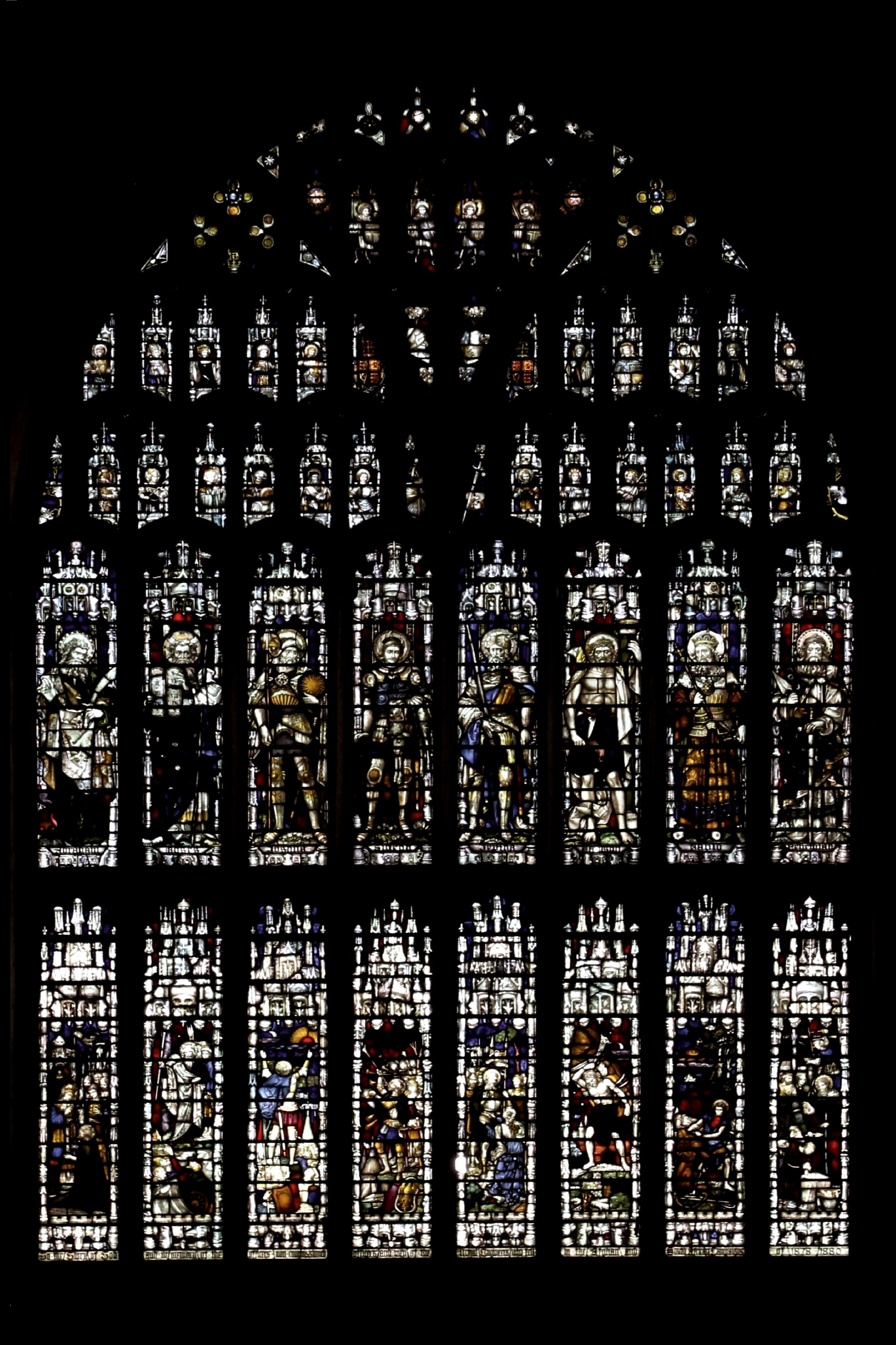Stories in stained glass
Lyndall Hacker and David Maxwell introduce the seventy-two brilliant stained glass windows of the Cathedral by prominent glaziers of the Victorian era. Featured in The Friends of Rochester Cathedral Annual Report for 2011.
The Victorian influence on stained glass, which persisted into the early 20th century, is at last being given the recognition it so richly deserves.
Abraham, Moses, Joshua, Gideon, Jeptha, Samson, David and Nehemiah, Great West Window. Clayton & Bell, unveiled 1883. Inscription in tympanum over West Door records the dedication to Officers, NC Officers, and Men of the Royal Engineers who died in various campaigns between 1838 and 1881. The upper lights contain single figures from the Old Testament (from south to north, Abraham, Moses, Joshua, Gideon, Jeptha, Samson, David and Nehemiah) with corresponding scenes of incidents in their lives in the lower lights. In the arch of the window are twelve small lights in which are Old Testament figures. Above are ten small lights showing military saints. In the middle of both rows of lights and in the head of the arch are emblematic subjects connected with the Corps of Royal Engineers.
Glass staining and painting, once an integral part of religious architecture, had all but ceased in England by the dawn of the 19th century. The far-reaching spiritual and artistic influences of the Oxford Tractarian Movement in the 1840s reversed this and gave rise to the greatest flowering of stained glass manufacture since the Middle Ages.
Rochester Cathedral has an exceptionally fine legacy from glaziers who replicated the spiritual aims and artistic beauty of their medieval predecessors. Their windows wrap around the building in subtly different styles with palettes of vibrant colours, evoking biblical narratives and local history.
The window illustrations, brief descriptions and notes on the glaziers are meant purely as a guide. Only by looking at the windows themselves can their true beauty be appreciated. We hope your interest will engender a greater appreciation of these luminous tapestries and encourage support for a comprehensive future publication.
I: Sts George & Elizabeth (Kempe 1900). George stands with lance and shield on a dead dragon.
(Wheat sheaf, bottom left hand corner). Elizabeth is elderly, her hair veiled. Her son, John, in camel hair shorts, holds a lamb with a cruciform halo and the resurrection banner, symbolising Christ.
2: Sts Christopher & Nicholas (Powell of Whitefriars, 1920). St Christopher carries the Christ Child and St Nicholas, Bishop and patron saint of sailors, holds a galleon. Lord Nelson appears in a roundel above. Inscription 'To the memory of Captain J.S. Dick RN and the officers and men of HMS Vanguard who lost their lives when that ship was destroyed on 9th July 1917 by an internal explosion at Scapa Flow. Erected by their relatives and the officers and men of the 4th Battle Squadron'. West, inscription 'St Christopher'. Above, figure of the Saint carrying the child Christ across a river. Below, a scene of the saint with an old man, a hermit. East, inscription 'St Nicholas'. Above, figure of the saint in bishop's vestments, holding a ship and a crosier. Below, a scene of the vision of St Nicholas appearing to sailors in a storm. Head light, bust of Nelson and 'The Nile 1798' in a roundel. Inscription below, 'HMS Vanguard'.
3: Christ as Saviour of the World (C&B, 1869).
Christ holds a cross and a three-sectioned orb symbolising the world: comprising Europe, Africa and Asia (the only continents known in medieval times). Below, St Stephen is on trial before the Sanhedrin. He is praying as he lifts his chained hands toward his Saviour.
4: St William of Perth (Comper, 1911). The right-hand pair of windows behind Walter de Merton's tomb show, on the left, St William of Perth in pilgrim dress holding a staff with a scallop on his hat and bag. Murdered outside Rochester in 1201 and buried in the Cathedral, he became a magnet for pilgrims. The other light shows John the Baptist with Comper's strawberry motif below his left foot.
Charles Eamer Kempe (1837-1907) (Wheat sheaf motif)
Kempe, one of the giants among Victorian glass artists and deeply involved with the Tractarian Movement, learnt the elements of his craft with the leading firm of Clayton & Bell. His extravagant use of prime colours, silver staining, the delicate and detailed painting of the figures and their settings, elaborate angels' wings of peacock feathers and jewel-encrusted garments, combined to produce his own distinctive style which was essentially a new and refreshing interpretation of the medieval English tradition.
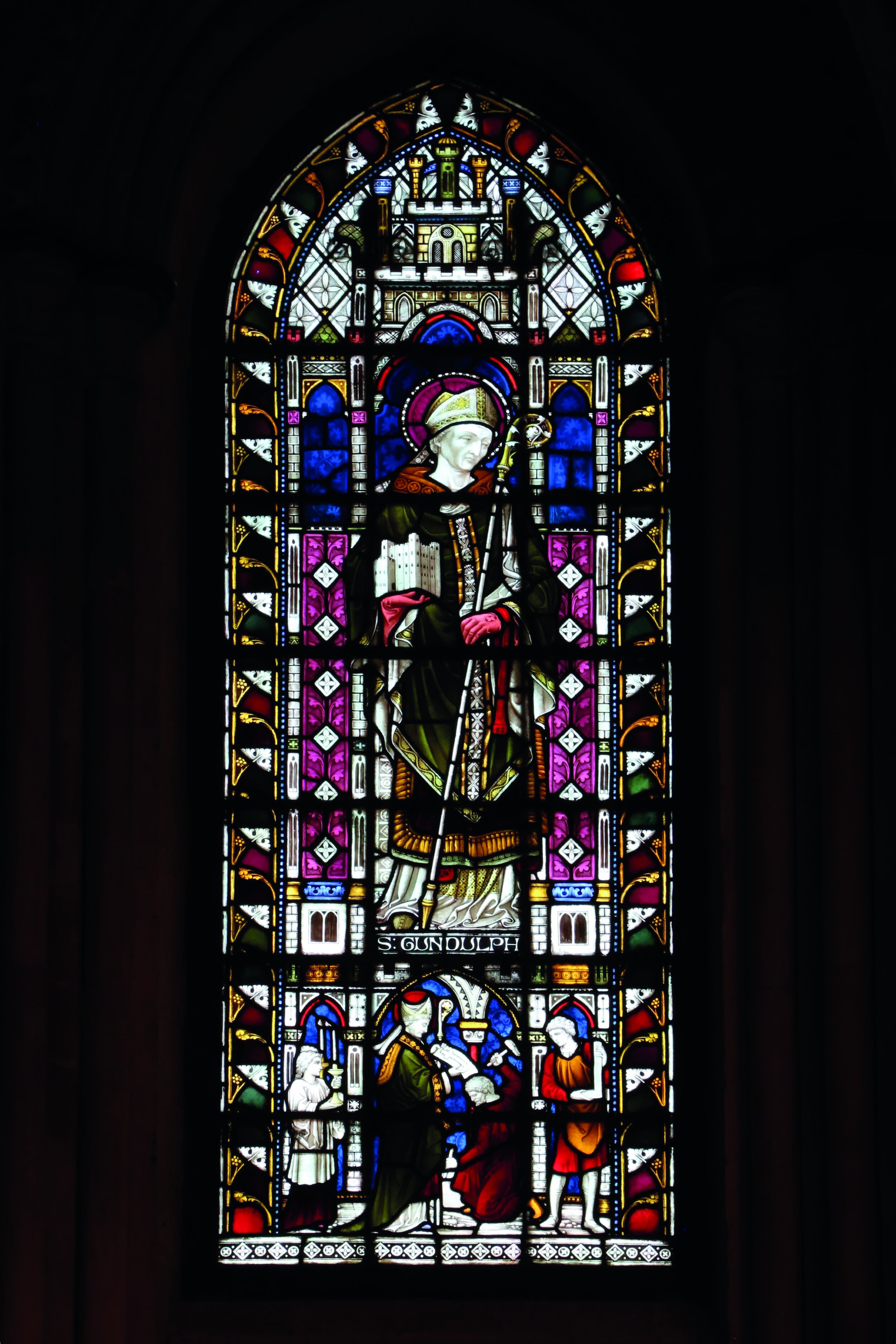
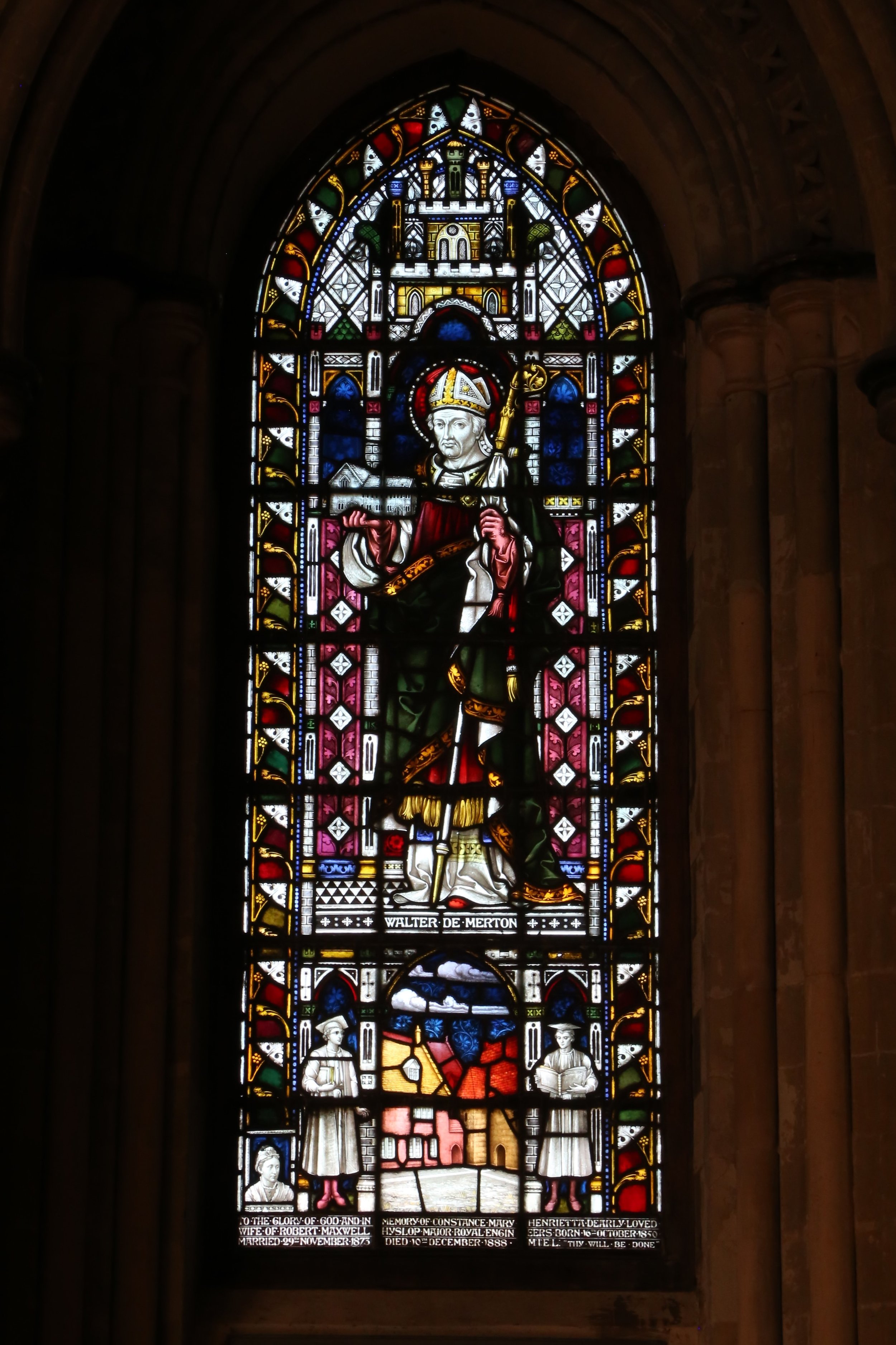
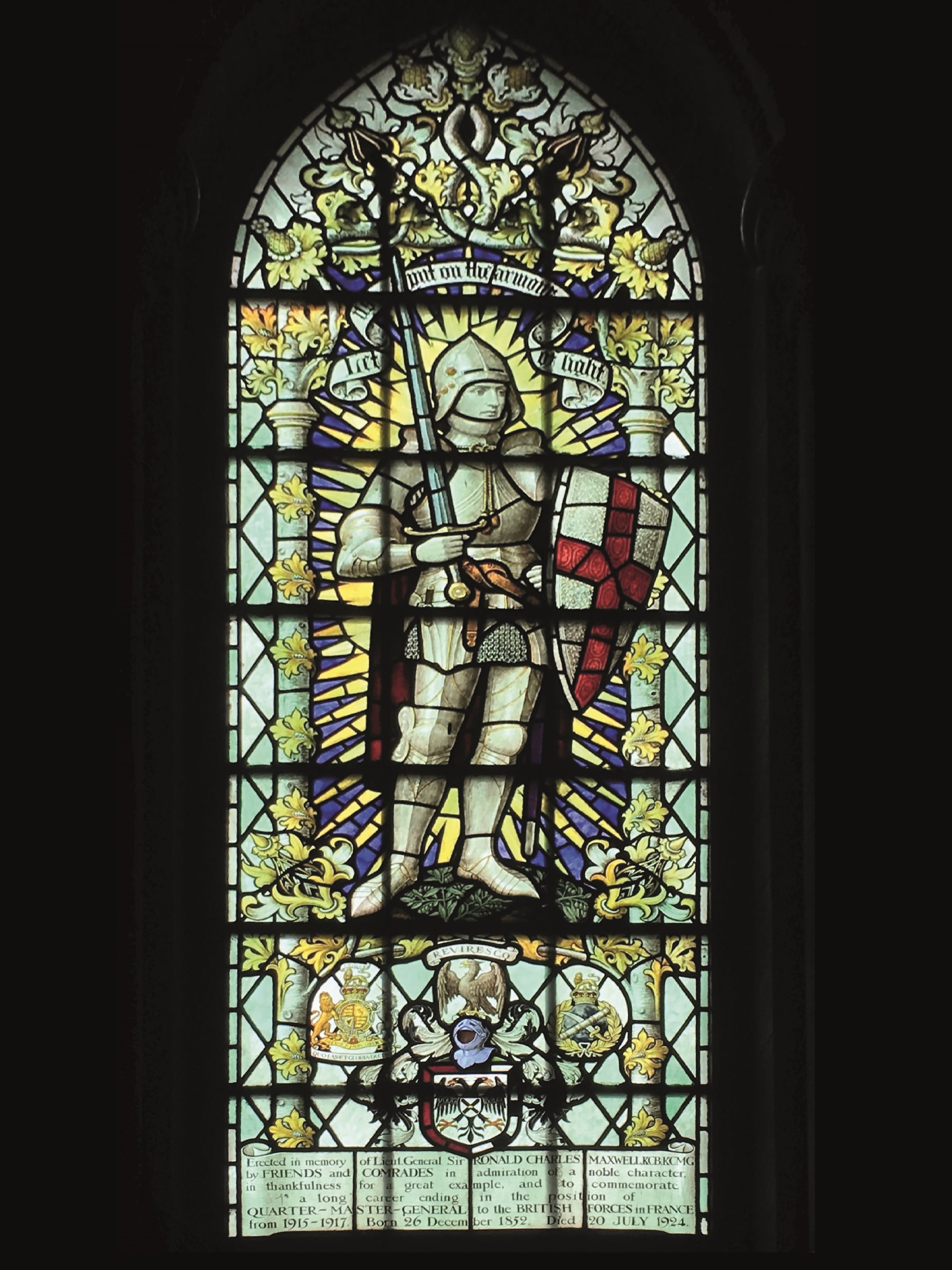
5. Gundulf (C&B, 1885). William I brought Gundulf to England for his piety and engineering skills. Famous for his design of the Tower of London, as Bishop of Rochester (1077-|108) he founded a Benedictine monastery here, designed this Norman Cathedral and undertook work on Rochester Castle. He holds a model of the castle (and a plan of the Cathedral in the scene below, where he is surrounded by workmen). His halo is unmerited as he was never canonized!
6. Walter de Merton (C&B, c1888), Chancellor of England under Henry Ill and Bishop of Rochester under Edward I, holds a model of Merton College which he founded with his eight nephews in mind! Perhaps two of them are in the scene below. A portrait of Mrs Maxwell Hyslop, the dedicatee, appears in the left-hand corner.
7: St George (F&G, 1929). Inscription 'Erected in memory of Lieut. General Sir Ronald Charles Maxwell, KCB KCM/by his Friends and Comrades in admiration of a noble character/in thankfulness for a great example and to commemorate/a long career ending in the position of Quarter-Master-General to the British Forces in France/from 1915-1917. Born 26th December 1852, died 20th July 1924. The window depicts St George in armour with drawn sword and shield with a red cross, all in a sunburst. A scroll above the figure has the words Let us put on the Armour of Light. Below are the arms of Gen Maxwell and badges of the Royal Engineers.
James Powell (1774-1840) (Monk motif)
Powell bought the Whitefriars glass factory in 1834 for his three sons. Initially they were ignorant of the art of glass making, but soon acquired the skills needed and adapted and improved upon the new technologies of the industrial revolution. Powell of Whitefriars became Britain's longest-running, most productive and innovative glass company and its association with designers such as Edward Burne-Jones and William Morris ensured that their windows reflected the fashion of the day.
Forsyth & Grylls
Window 7, 1924, suggests an interesting collaboration in which W A Forsyth, architect and designer for Comper and J Powell & Sons, gained the commission and H Grylls, the glazier, carried it out.
Clayton & Bell
This London-based company was founded in 1855 by John Clayton (1826-1913) and Alfred Bell (1832-1895). They specialised in inventive recreations of mediaeval glass marked by simple, linear designs and strong clear colours and were influenced by the Pre-Raphaelite movement. The firm became one of the largest and most celebrated names in the field of stained glass in the country.
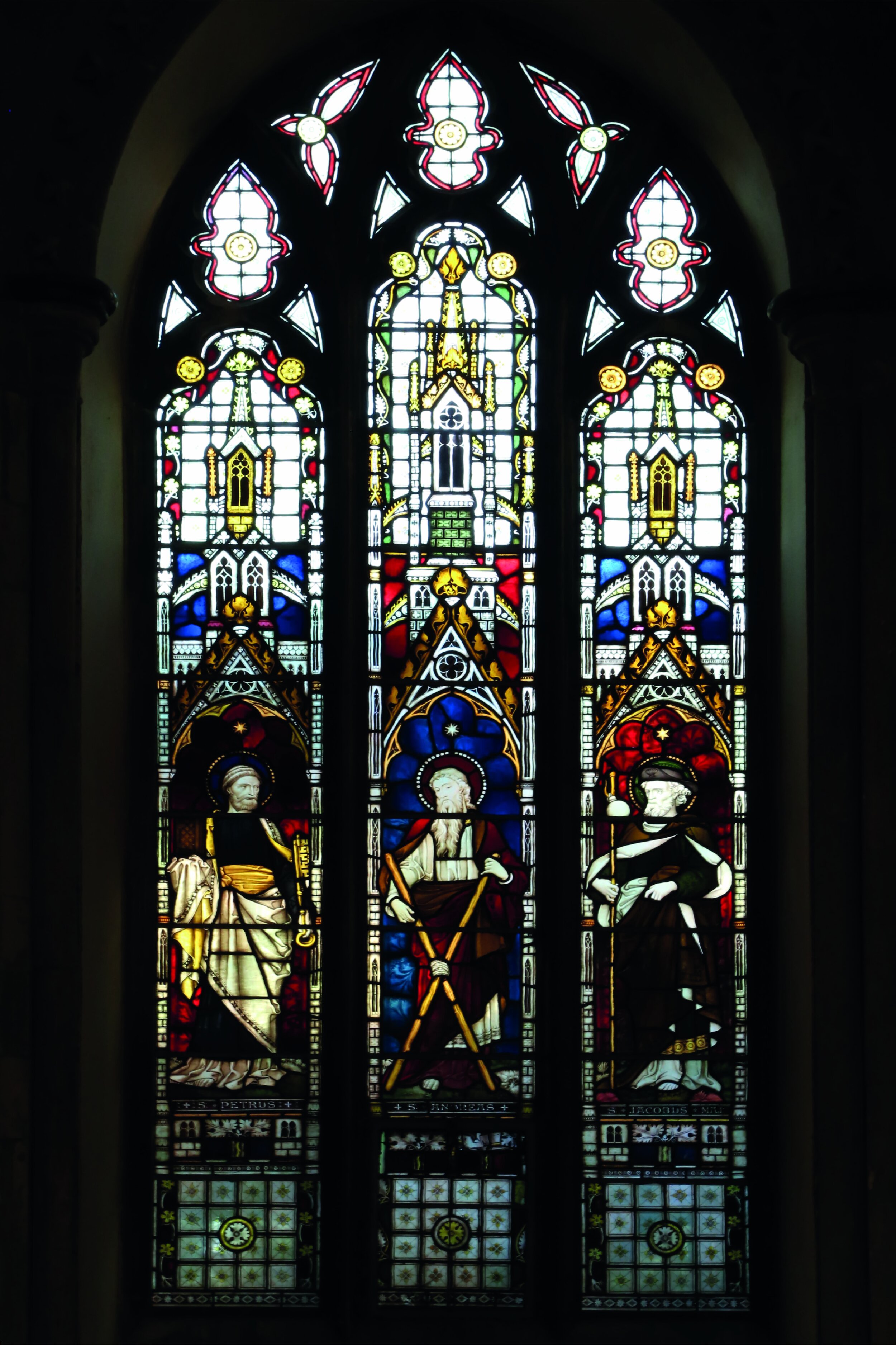
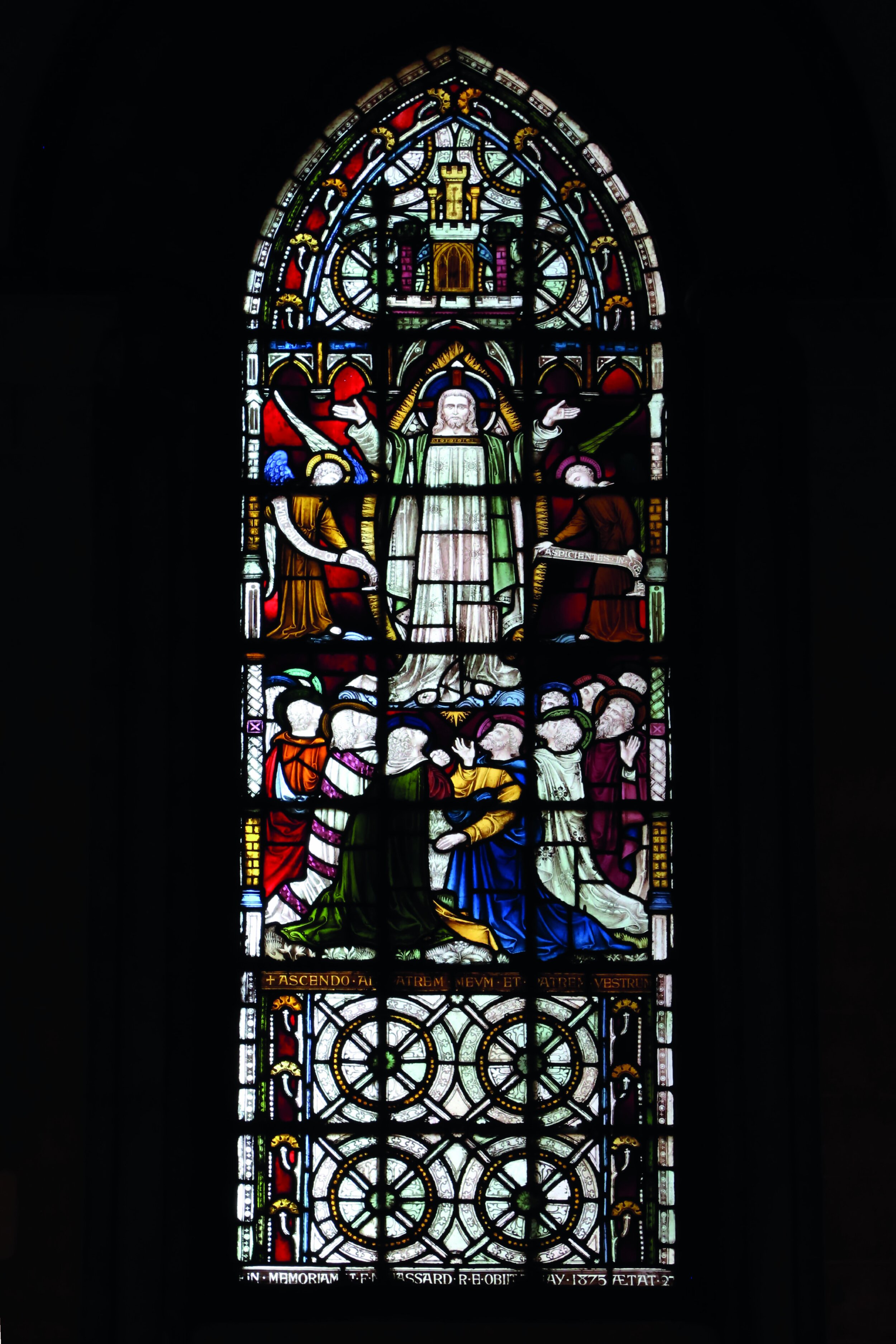
8: The Good Shepherd (The Presbytery windows are by C&B: this one is after 1875).
All the figures in this triple-lancet window, shown with cruciform halos holding shepherd's crooks and surrounded by sheep, represent Christ as The Good Shepherd.
9: The Ascension
(C&B, 1873) of Christ portrays Him in a mandorla (a space appropriately named from the Italian for almond) flanked by two angels who hold a scroll with the words which He is speaking to his disciples gathered below "Ye men of Galilee, why stand ye gazing up into heaven?"
10. Christ in Glory (C&B, 1873). This shows Christ crowned and in a mandoria.
Symbols of the four evangelists appear, one at each corner: John (Eagle), Luke (Bull), Mark (Lion) and Matthew (Winged man), the whole beneath an architectural canopy.
11. Sts Peter, Andrew and James the Elder (C&B, post-1897). Christ promised Peter the "keys of the kingdom of heaven" which he holds. Andrew stands with a saltire cross on which, according to tradition, he was crucified. James, patron saint of pilgrims, is depicted with his attributes of a staff, a gourd for carrying water and a scallop shell on his hat.
Three scenes from the life of Jonathan, North Nave Aisle west end
Clayton & Bell, unveiled 1883. Inscription at base 'In memory of Thomas Rice Henn, Lieutenant Royal Engineers/Killed in Action at Maiwand Afghanistan 27th July1880. Faithful unto Death'. Three scenes from the life of Jonathan arranged in a vertical row of three roundels, each encircled with a Latin text from the First Book of Samuel.
Sir Ninian Comper (1864-1960) (Strawberry motif)
Comper, originally an artist in stained and painted glass, became one of the 20th century's foremost ecclesiastical and monumental designers. Articled to C E Kempe, he is well known for his use of colour and his subtle integration of Classical and Gothic styles. His strawberry signature is a tribute to his father, who died while giving strawberries to poor children. Comper was knighted by King George VI in 1950 and worked almost up to the time of his death.
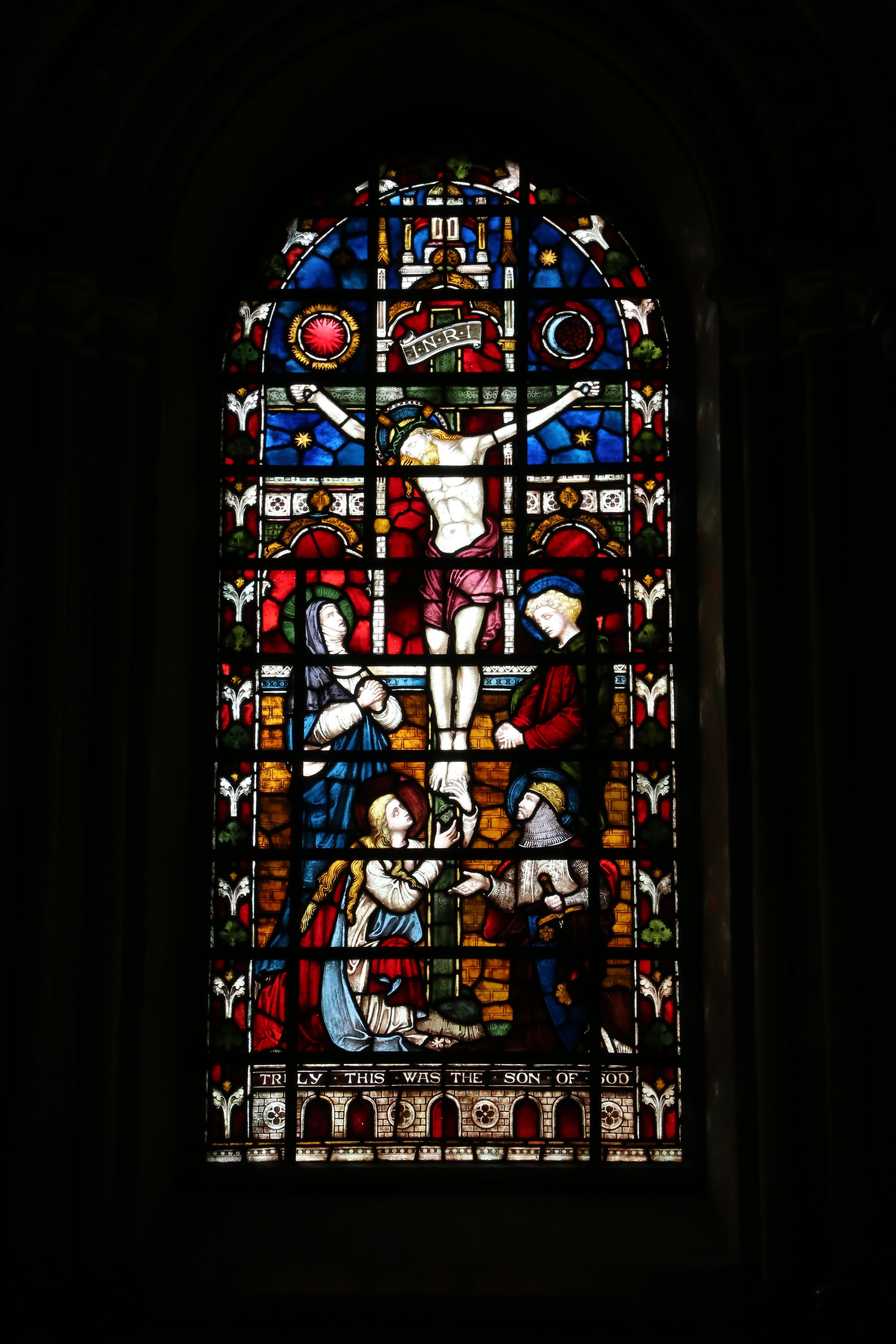
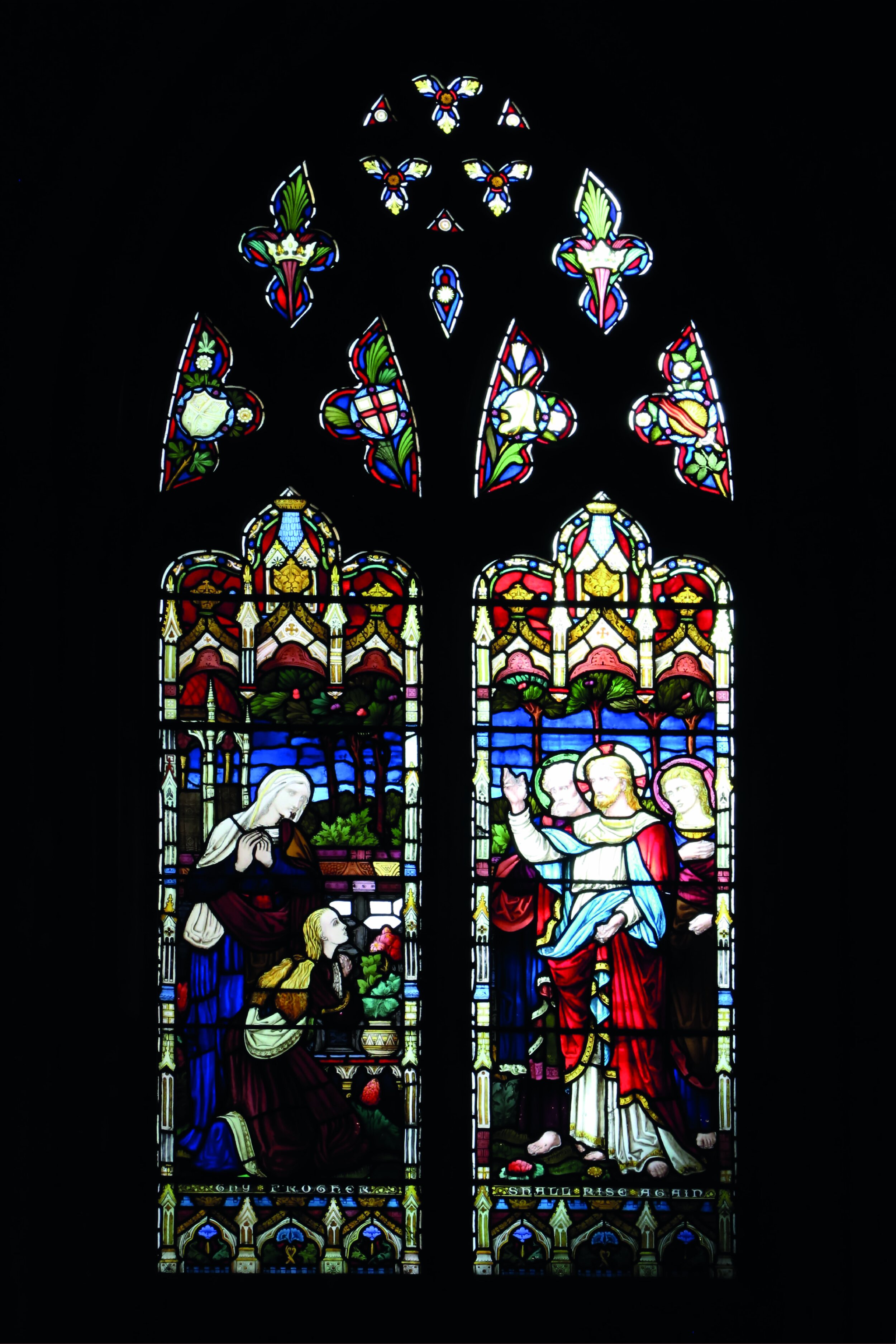
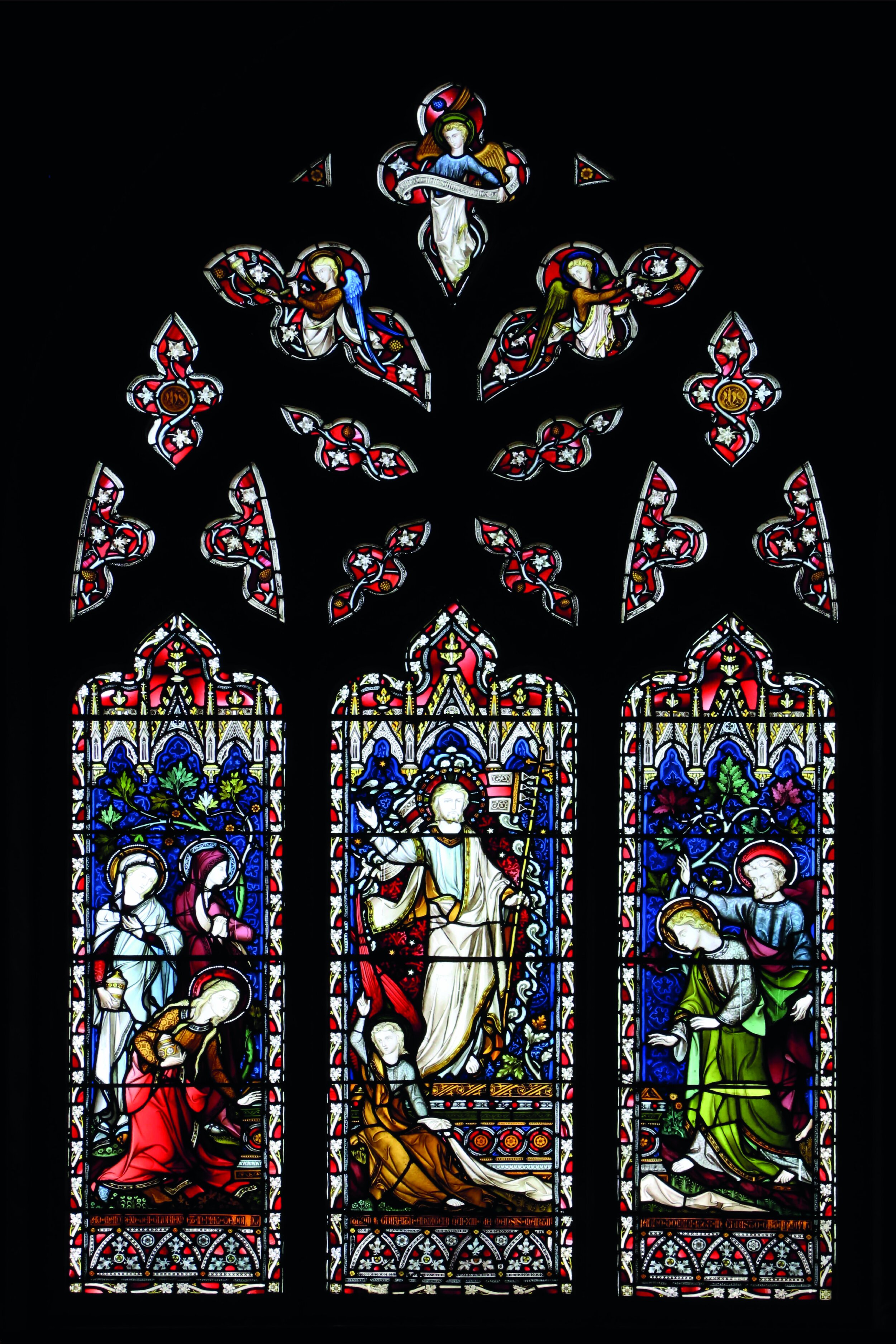
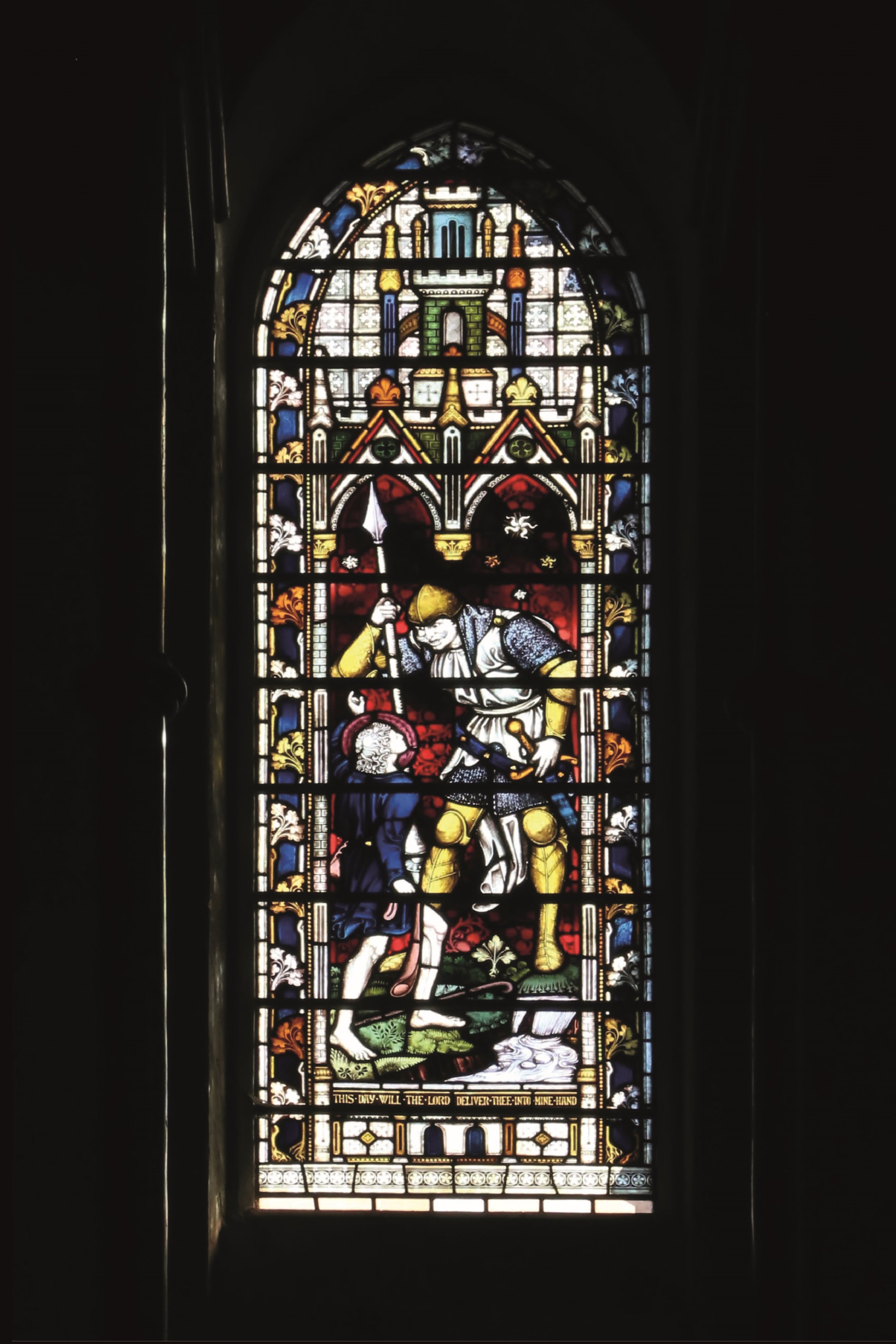
12. Jesus with Martha and Mary (A Gibbs, c1883). Christ's raised finger symbolises the fact that He is in the act of saying to the two sisters, in the words of the inscription below, that Thy brother (Lazarus) shall rise again from the dead. Above are cusped lights with crowned palms and military symbols as the window is dedicated to a soldier.
13: The Resurrection (Hardman, c1897). Christ rises from the tomb clasping the Resurrection Banner, an angel at His feet holds a winding sheet and Mary Magdalene accompanied by two women bring spices for embalming. Two disciples, John and Peter, look on. The tracery contains angels, one with a scroll proclaiming I Believe in the Resurrection and Christ's monogram IHS.
14. The Crucifixion (C&B, c1883). The crucified Christ is shown with the centurion portrayed as a medieval knight kneeling at the foot of the cross pronouncing the words of the inscription below: Truly this was the Son of God. Mary Magdalene also kneels and Christ's mother, Mary, and John stand on either side
15. David and Goliath (C&B, c1883). Goliath carries a spear and wears mediaeval armour and chain-mail. He looks down as David advances with his sling, uttering the words on the inscription: This day will the Lord deliver thee into mine hand.
Alexander Gibbs (1831-86) was the second of three sons (all called Alexander) of Isaac Alexander Gibbs (1802-51) who became stained-glass designers. Isaac started the family firm in 1848. The company that Alexander established around 1855 was still functioning in 1915. His work is typified by gentle-faced figures in somewhat gaudy clothes of rather discordant colour and fairly ornate detail.
John Hardman (1811-67). His Birmingham-based operation started as an ecclesiastical metal works. However, following encouragement from his close friend Augustus Welby N Pugin, Hardman & Company became one of the most notable pioneers of the stained glass revival of the 19th century and was of key importance both nationally and internationally. Hardman's profound respect for the 12th century shows in his use of ruby reds, deep blues and intricate tracery.
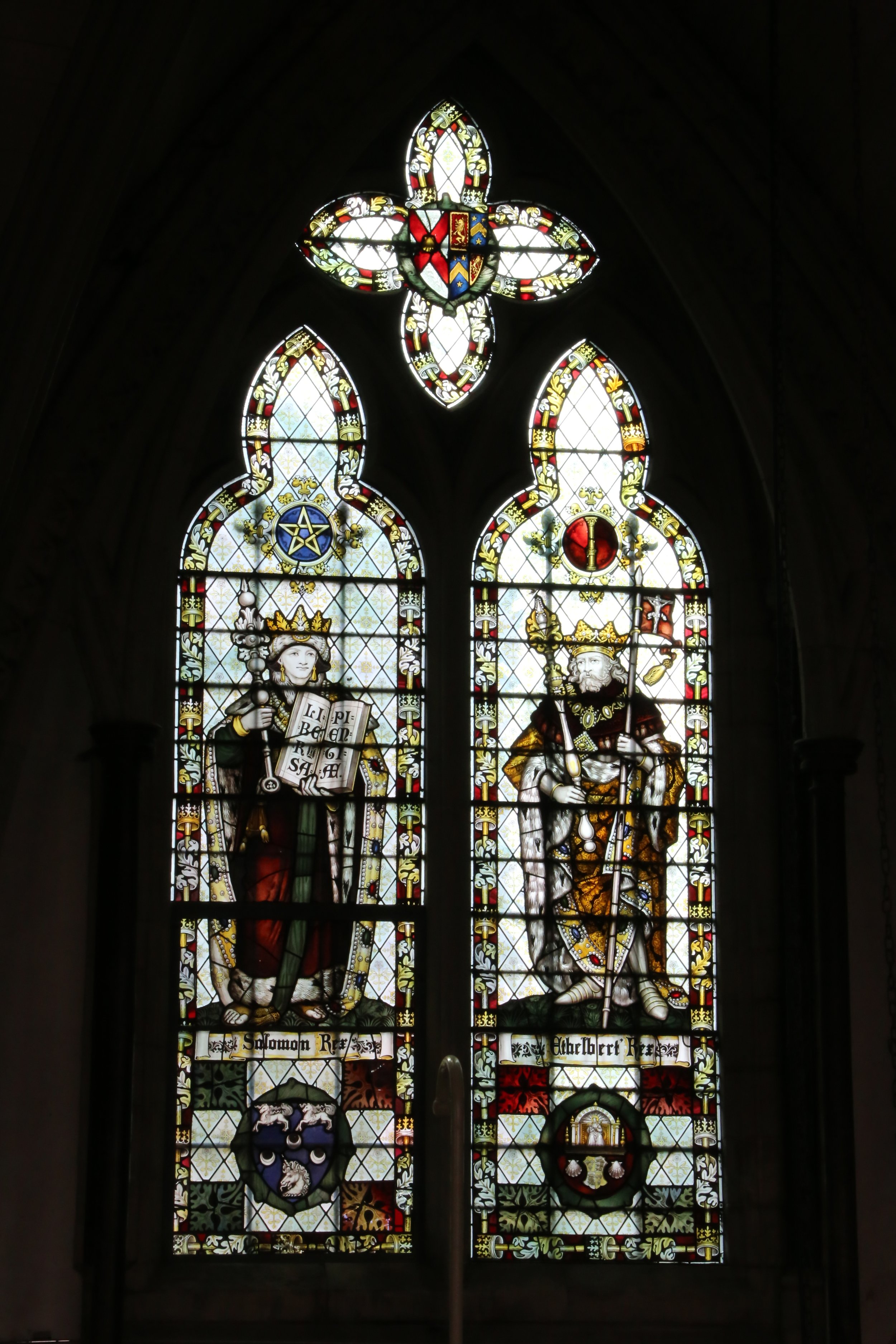
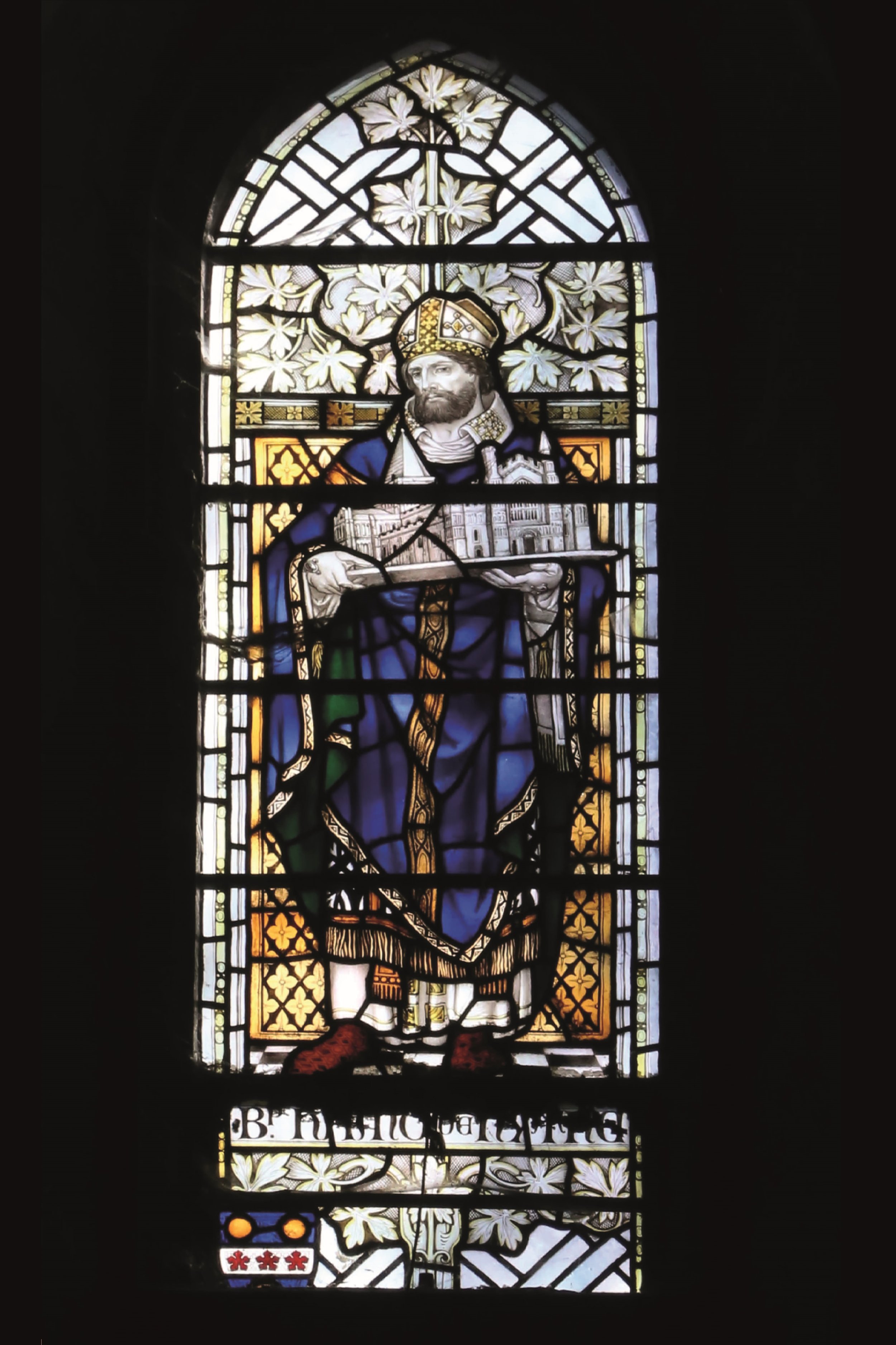
16: David (B&G, c1918). The window above the steps shows David playing his harp, with the inscription David took an harp and blayed with his hand. The angel above holds a scroll bearing the opening bars of Handel's Largo. The badge below is of the 15th Battalion London Regiment Civil Service Rifles, with whom the dedicatee served.
17: Ernulf (Powell of Whitefriars, c1917).
This Bishop (I| 15-25) holds a plan of the Cathedral which he did much to embellish. He compiled the influential Textus Roffensis which includes codified Anglo-Saxon manuscripts said to have influenced Magna Carta and the American Declaration of Independence. Windows 17 and 18 commemorate Thomas Hellyer Foord, founder of the almshouses on Priestfields, Rochester.
18. Hamo de Hythe (Powell of Whitefriars, c|917). This active 'builder bishop' holds a model of Rochester Cathedral which he enriched. His Decorated Chapter Room doorway, which has been described as "one of the most beautiful pieces of sculpture of its date (c1340) in existence" is in the South Choir Transept.
19. King Solomon and King Ethelbert (Kempe, 1 889) are identified by their inscriptions. Solomon was known for his wisdom and Ethelbert, as King of Kent, welcomed St Augustine in 597 on his missionary journey from Rome. Ethelbert converted to Christianity and in 604 granted land for an Anglo-Saxon Cathedral to be built, establishing Rochester as the second-oldest See after Canterbury. These lights were donated by Freemasons.
Aholiab, Bezalel, King Solomon, King Ethelbert, Bishop Gundulf, and Bishop Walter de Merton, south nave transept east wall
Kempe, 1899. Board on wall records this window and others were given by the Freemasons in commemoration of Dean Hole's appointment to a Grand Chaplaincy in the Grand Lodge of England. They were dedicated on St Andrew's Day 1899.
Burlison and Grylls
John Burlison (I 843-91) and Thomas Grylls (1845- 1913) were apprenticed with Clayton & Bell. They started their own company in 1868, which built up a considerable reputation for its fine work until it effectively stopped trading when the premises were bombed in 1945. The company's style shows a fondness for canopies and pale borders, a fine quality in the drawing of often-rounded faces and flowing garments, figures with elaborate brocade backdrops or Germanic landscapes, and a general 'lightness' of feeling.
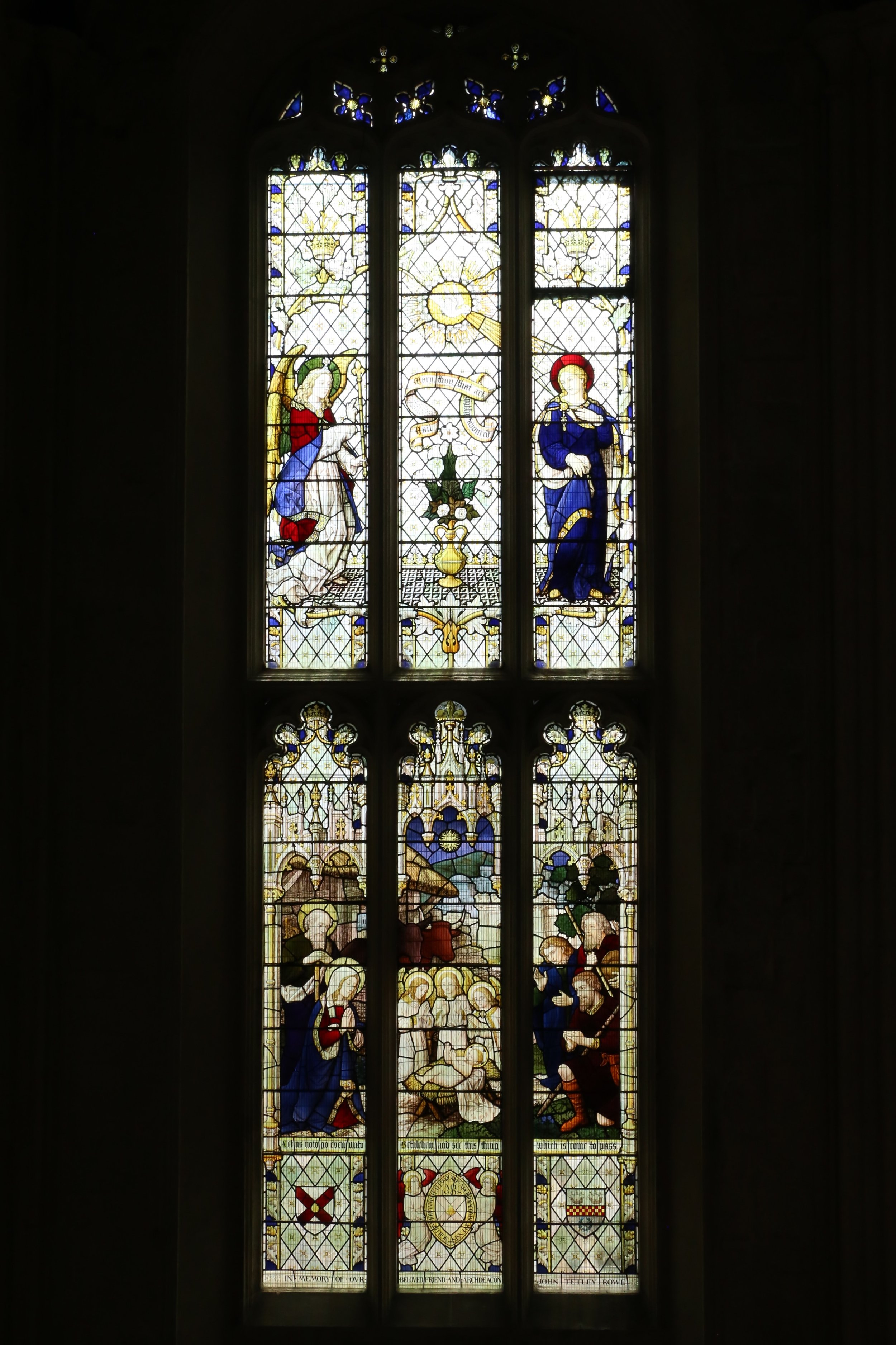
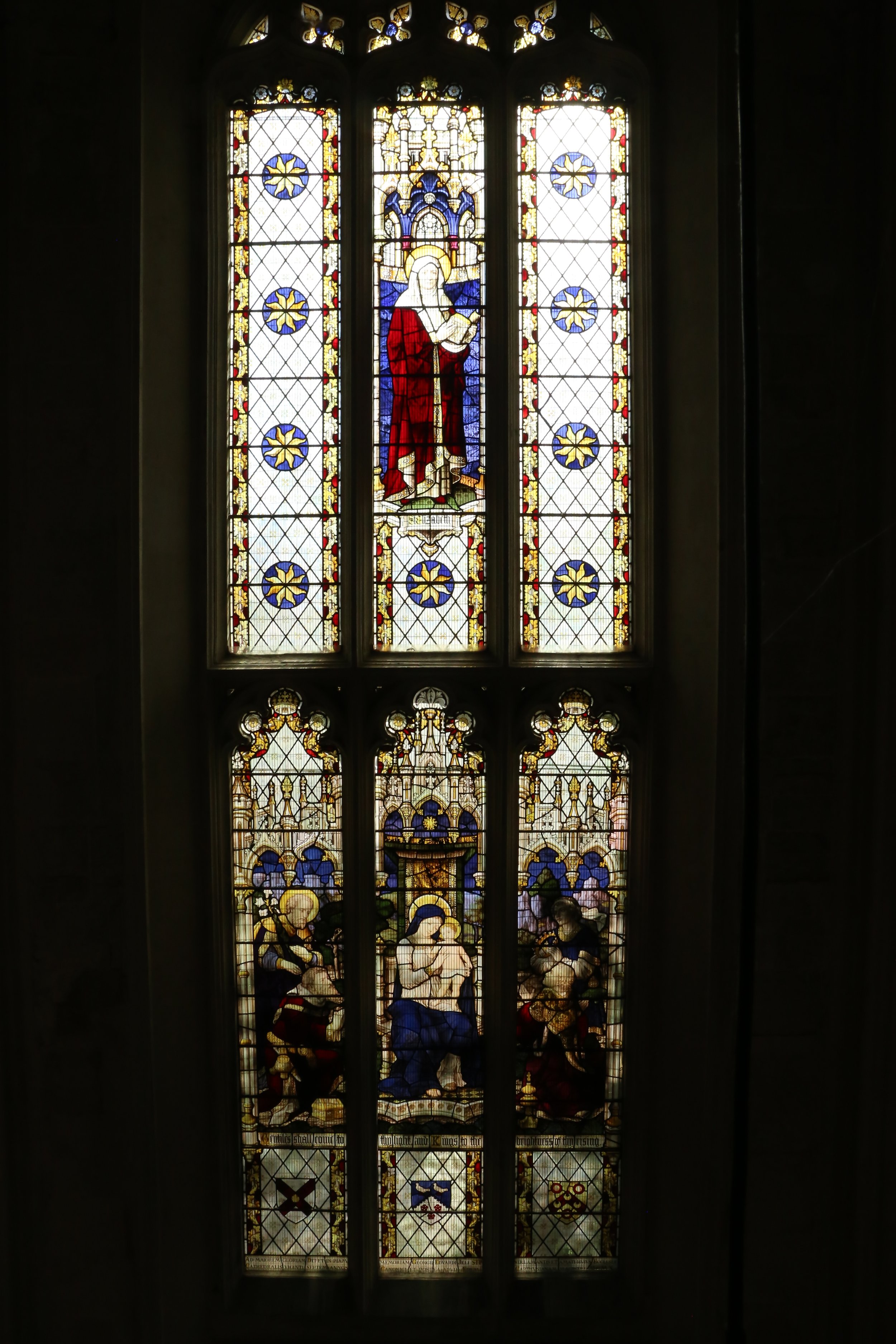
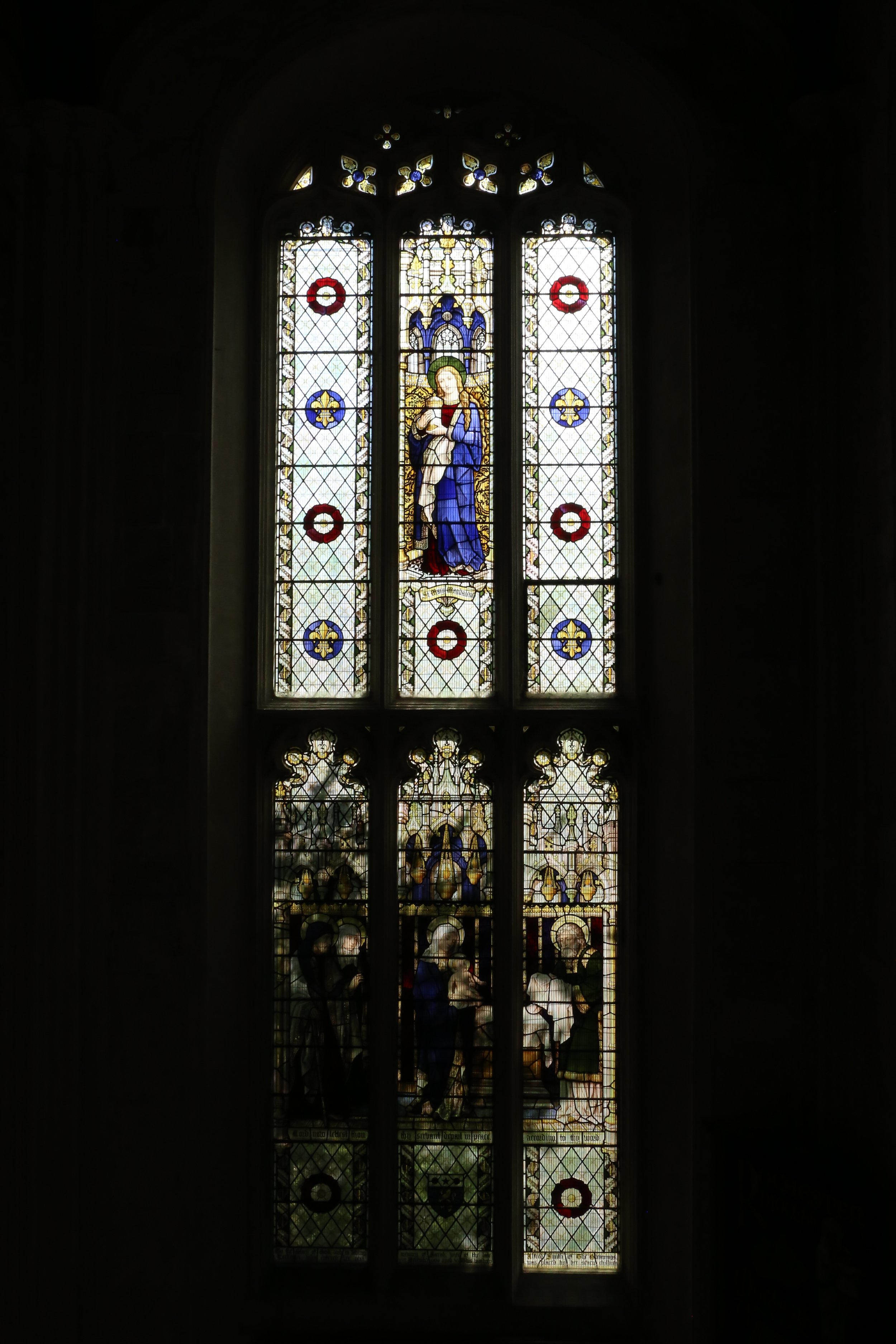
20: Sts Martin and Alban (C&B, 1888). Identified by their inscriptions, St Martin (d397) divides his cloak to give to a beggar and St Alban (d304), the first recorded British Christian martyr, wears mediaeval armour. The windows either side are dedicated by the Royal Engineers to comrades who died in various Victorian campaigns. They also commemorate General 'Chinese' Gordon, who taught in a Gravesend Sunday School and died defending Khartoum.
21. Christ's Nativity (All the windows in the Lady Chapel are by Burlison & Grylls). Christ lies in a manger while his Mother and Joseph, angels, an ox and an ass look on. Following Archangel Gabriel's visit to the shepherds, their resolve is expressed in the caption Let us go even unto Bethlehem and see this thing which is come to pass. They adore the Babe. 1914 -16. Six lights in two tiers divided by a transom. Inscription 'In memory of our beloved Friend and Archdeacon/John Tetley Rowe'. Upper lights. The Annunciation. East - the Angel Gabriel. Centre - scroll, 'Hail Mary thou art highly favoured', with a vase of roses and lilies below, and above, a dove in a sunburst, the rays of which point to the figure of Mary. West - Mary. Lower lights. The Nativity. East - Mary and Joseph. Below, Arms of See of Rochester. Centre - the crib surrounded by three angels, an ox and an ass, with the star in the sky above. Below, 'Sigellum Johannis Tetley Rowe Archidiaconi Roffensis A.D. 1908'. West - three shepherds. Below, Arms of Chatham. Inscription beneath 'Let us go even unto Bethlehem and see this thing which is come to pass'.
22. The Epiphany Christ stands on Mary's lap while Joseph leans on his flowering wand. The three Magi are shown as elderly, middle-aged, black and young to indicate that the Christian message is for all generations in all the world (then thought to consist of three continents: Europe, Africa and Asia). The caption: Gentiles shall come to thy light and Kings to the brightness of thy rising, encapsulates this. The Magi's gifts: a gold crown for kingship, a box of frankincense for priesthood and a vessel of myrrh for suffering, symbolise aspects of Christ's future life. Six lights in two tiers divided by a transom. Inscription 'Ad majorem Gloriam Dei et in Piam/Memoriam Georgii Edwardi Jelf S.T.P./Viri Amantis et Amati Huius Ecclesiae/Cathedralis Viginti & Septem Annos/Canonici et Postea Apud Aedem/Carthusianam Magistri MCMX'. Upper lights. Centre - St Elizabeth. West and east lights - stylized stars in roundels. Lower lights The Epiphany. East - Joseph with a flowering wand and one of the Magi, kneeling, with a box of frankincense. Centre - Mary seated on a canopied chair with the Christ child. West - two Magi, one with a gold crown, the other with a container of myrrh. The whole scene across three lights set in a landscape of trees, rocks and a medieval building and beneath a canopy. Inscription below 'Gentiles shall come to thy light and Kings to the brightness of thy rising'.
23. The Presentation Simeon, the high priest, recognises Christ whom God had promised he would live to see. He prays "Lord, now lettest thou thy servant depart in peace according to thy word" as Mary, and Anna a prophetess, watch. Six lights in two tiers divided by a transom. Inscription 'To the glory of God and in loving memory of Sarah, wife of the late Alfred Smith of The Gleanings, Rochester, who entered her rest 23rd December 1909 aged 80. This window was place by her seven children'. Upper lights. Centre - St Mary Magdalen, flanked by symbols in the east and west lights, alternating the Tudor rose and the fleur-de-lys. Lower lights. The Presentation. Inscription 'Lord now lettest thou thy servant depart in peace according to thy word'.
St Margaret of Scotland and The Crucifiction, Lady Chapel west wall (1 of 2)
Burlison & Grylls. Six lights in two tiers divided by a transom. Inscription 'To the memory of my father William Gunn M.D., R.N. (1808-1890) who for many years lived in this city and worshipped in this Cathedral Church D.G.' Upper lights, St Margaret of Scotland, flanked by symbols alternating the thistle and the fouled anchor. Lower light, the Crucifixion with Mary and John on either side. 'I, if I be lifted up from the earth, will draw all men unto me'.
St George, King Arthur, St Michael, St Peter and St John, and The Risen Lord, Lady Chapel (3 of 3)
King's School Memorial Window. Burlison & Grylls. Dedicated 11th December 1920. Six lights in two tiers divided by a transom. Inscription 'To the Glory of God and in Proud and Abiding Memory of the following Old Roffensians who laid down their lives for their country in the Great War (1914-18)'. (Tablet with names fixed underneath). Upper lights contain single figures standing on bases of simple design and beneath canopies. South - St George, holding a banner and standing on the dragon. Centre - King Arthur, holding Excalibur aloft with, beneath, the Arms of King Henry VIII. North - St Michael, transfixing the dragon. Lower lights. South - St Peter and St John. Arms of See of Rochester. Centre - The Risen Lord, carrying banner of the resurrection with, beneath, Arms of County of Kent. 'As by man came death, by man came also the resurrection of the dead'.
Life of Judas Maccabeus; South Nave Aisle west end
Clayton & Bell, unveiled 1883. Inscription at base 'In memory of Anthony William Durnford. Colonel Royal Engineers/Killed in Action Isandhlwana South Africa Jan 1879'. Three scenes from the life of Judas Maccabeus, each encircled with a Latin text from the Book of Maccabees.
St George, St Elizabeth, St John the Baptist; North Nave Aisle, north wall 1 of 3
Kempe; 1900. Brass mural plate below records 'To the Glory of God/and in ever loving memory of/Elizabeth Nicholson/who died October 24th 1899 in her 88th year. This window is dedicated by her surviving children'. (Physick No 4. Inv. No. 000004). Two lights. West - Inscription 'S'tus Georgius'. Above, figure of the Saint with lance, shield and dead dragon; East - inscription 'S' ta Elizabetha'. Above, figure of the saint with Saint John the Baptist as a child holding a reed cross and a framed representation of the Lamb of God. Each figure is under an architectural canopy with an angel above.
St Francis of Assisi and St Hubert; North Nave Aisle, north wall 2 of 3
Powell, unveiled Dec 26th 1927. Inscription 'This window the gift of friends is dedicated to the glory of God and in honoured/memory of Ivo Francis Walter Bligh, Eighth Earl of Darnley. A devout Christian and active churchman and a true sportsman greatly beloved. He entered into rest on 10th April 1927 in the sixty ninth year of his age'. Two lights. West, inscription 'St Francis of Assisi'. Above, figure of the Saint in brown habit and girdle holding up a cross and surrounded by birds, under an architectural canopy. Below, a scene of S. Francis with birds and a follower. East, inscription 'St Hubert'. Above, figure of the Saint wearing bishop's robes and mitre, with a stag, under an architectural canopy. Below, a scene of S. Hubert kneeling before the vision of a crucifix between the antlers of a stag. Head light - the arms/crest of the Earl of Darnley
Crucifix, south nave aisle west end triforium
Sienna Onyx window; Pieces of Sienna onyx leaded; arranged in a small round headed Norman window, so that darker brown pieces form a cross on a lighter brown ground. Gift of Canon Livett 1929.
Peter walking on the water, Christ stilling the tempest, south nave aisle south wall (1 of 2)
Clayton & Bell, 1891. Mural brass plate 'To the Glory of God and in loving memory of Reginald Da Costa Porter, Lieutenant, Royal Engineers who died August 28th 1882 from an injury received when serving as second in command of the pontoon troop of the Royal Engineers in the Egyptian expedition of that year'. (Physick No.127). Two scenes. Upper part - Peter walking on the water. Inscription 'Beginning to sink he cried: Lord save me'. Lower part - Christ stilling the tempest. Inscription 'He arose and rebuked the winds and the sea'.
St Luke, south nave aisle south wall (1 of 2)
Clayton & Bell, des. Frampton, 1904. Brass plate beneath 'To the Glory of God and in memory of Frederick Stewart Cobb, this window is dedicated by some of his friends… He was born in this city December 24th 1841. He was a King's Scholar and for seven years British Postmaster at Constantinople where he died February 16th 1899'. Figure of St Luke.
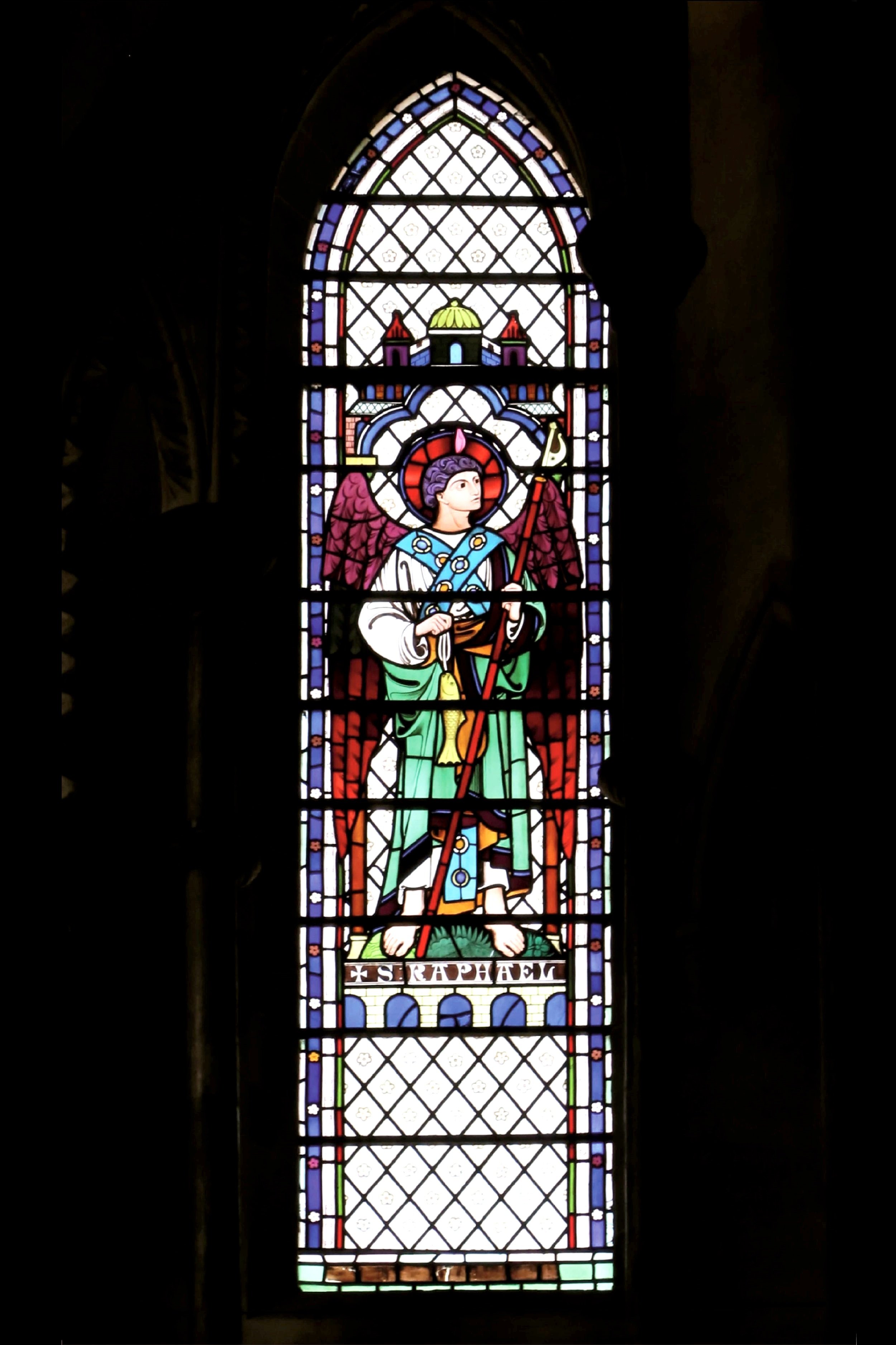
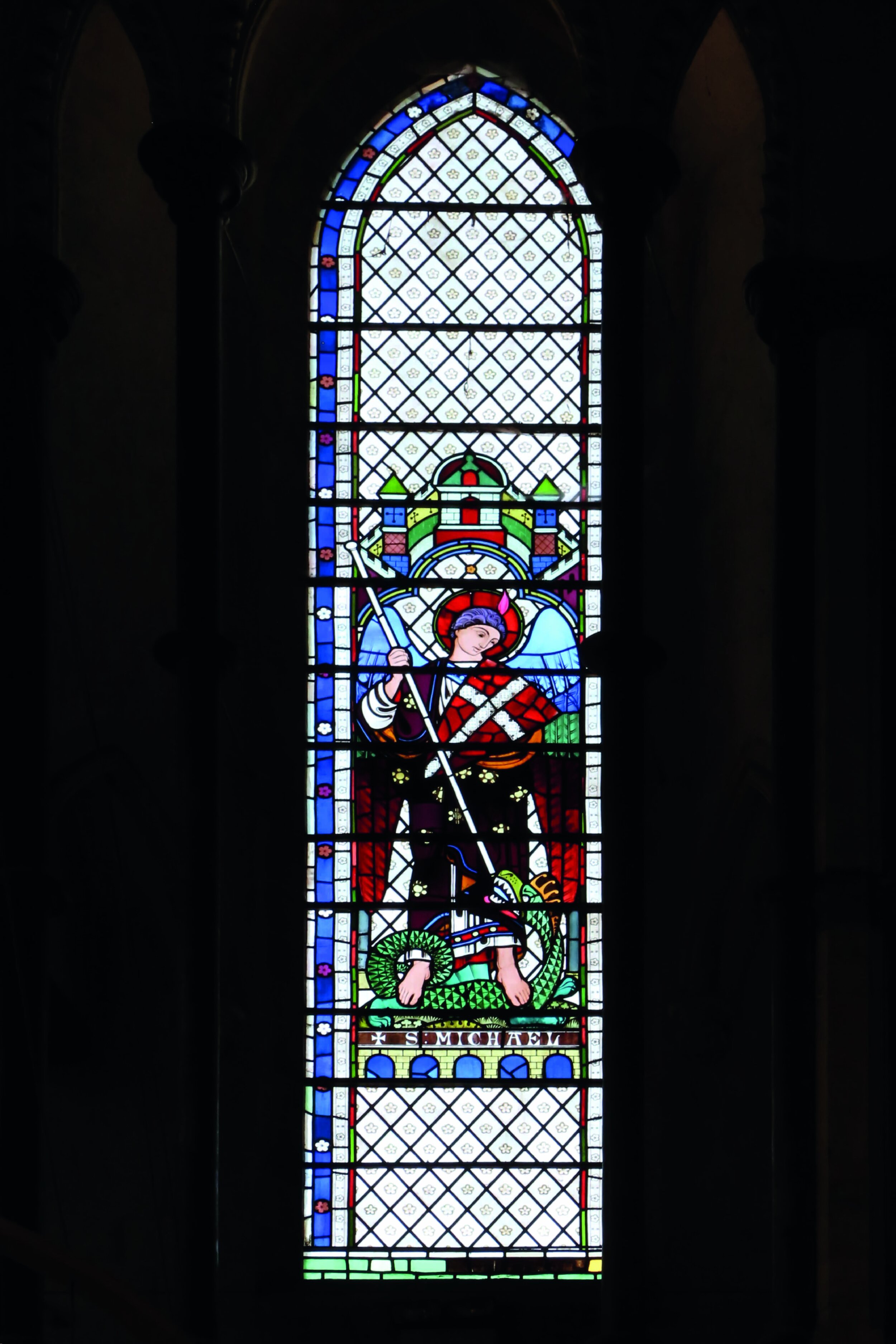
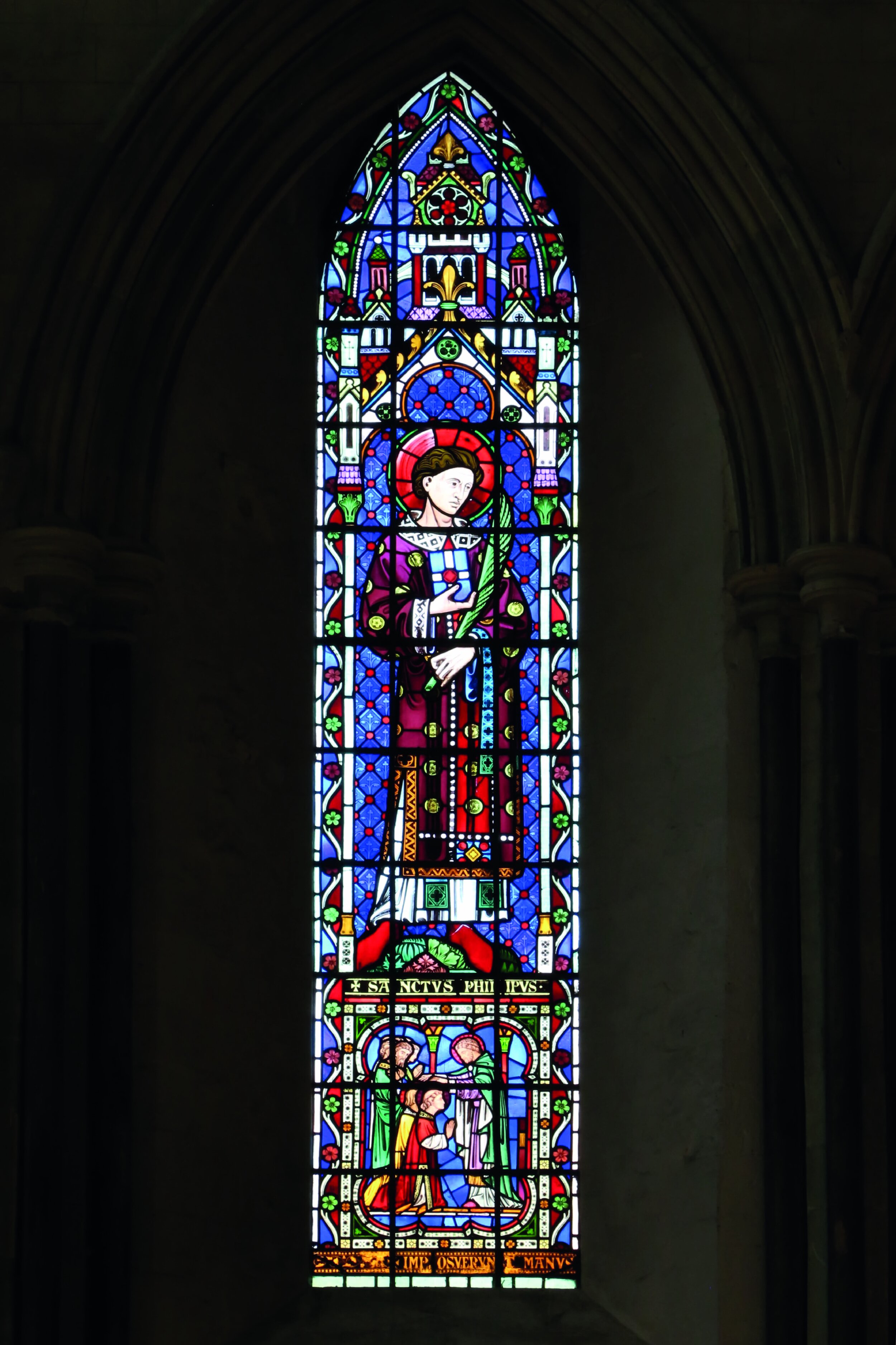
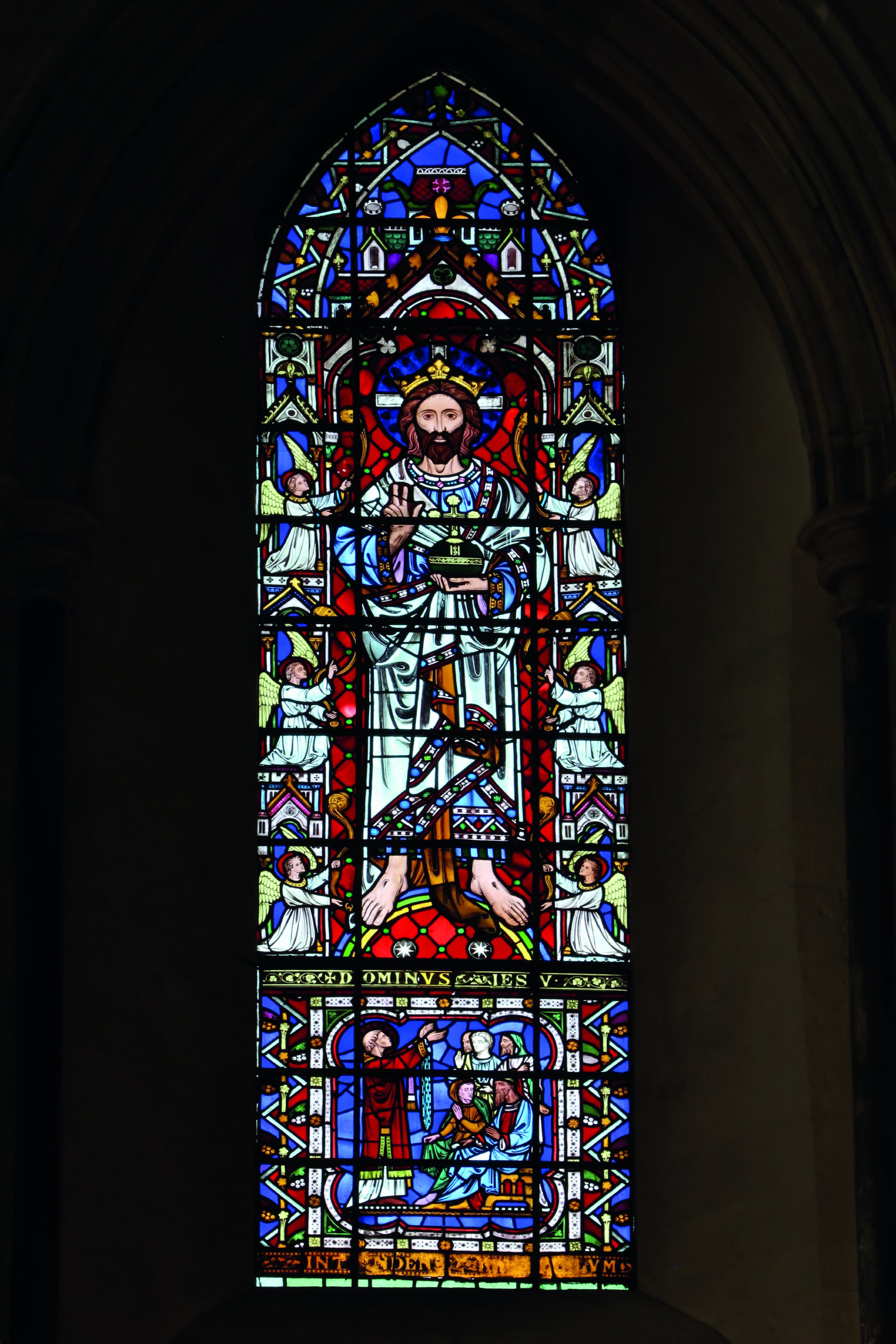
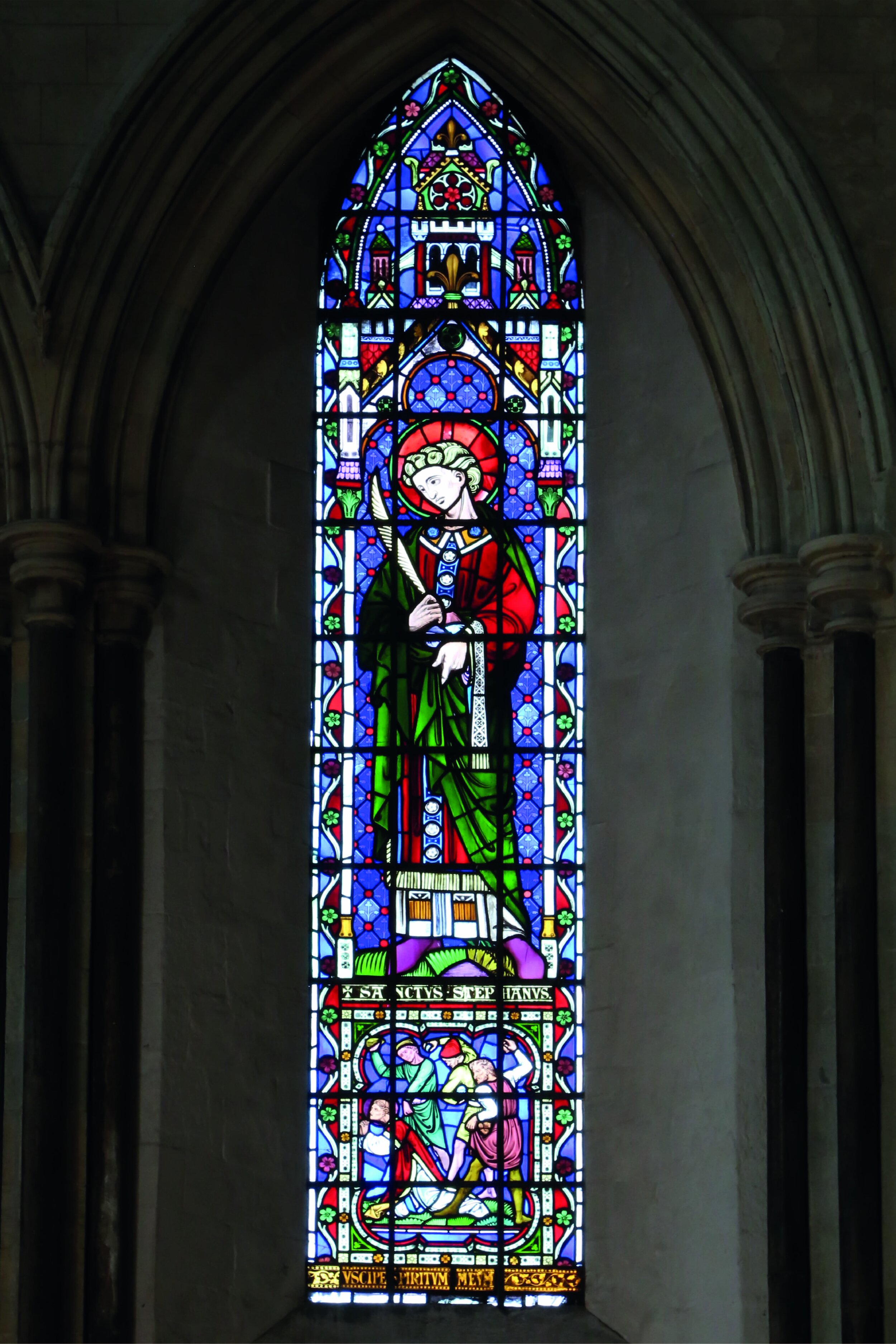
St Phillip, Laying on of Hands, Christ the Saviour, St. Stephen, St. Raphael, St.Michael, Gabriel, North Nave Transept
Clayton & Bell, 1859. Memorial windows to Archdeacon King. Two tiers each of three lancets. Lower tier west, inscription 'Sanctus Philipus'. Above, figure of the Saint holding a book and a palm, under a canopy. Below, representation of the laying on of hands and inscription 'Imposuerunt Manus'. Centre, inscription 'Dominus Jesu'. Above, figure of Christ as Saviour of the World with right hand held in benediction, and holding an orb surmounted by a cross in left hand, beneath a canopy, with three angels on either side. Below, a scene with six figures, including a saint in chains before a judge. Inscription (worn) 'Intendens in caelum'. East - inscription 'Sanctus Stephanus'. Above, figure of the saint holding a palm, and stones in the fold of his robe, under a canopy. Below, a scene of Stephen being stoned, inscription 'Suscipe (S)piritum meum'. Upper tier. West, inscription 'S Raphael'. Above, figure of Raphael holding a fish and a staff with a pilgrim's bag(?). Centre, inscription 'S Michael'. Above, figure of Michael spearing the dragon, with a shield in his left hand. East, inscription 'S Gabriel'. Above, figure of Gabriel holding a lily and in the other hand a scroll with the words 'Ave Maria'. Repaired 1987.
St Maurice, St Nicholas, St George, St James and St Adrian, south nave transept south wall upper tier
Clayton & Bell, 1888. Inscription 'In memory of the Officers of Royal Engineers who served in the Peninsula and at Waterloo. These windows are inserted 1888/by the Corps of Royal Engineers'. One of a set of five.
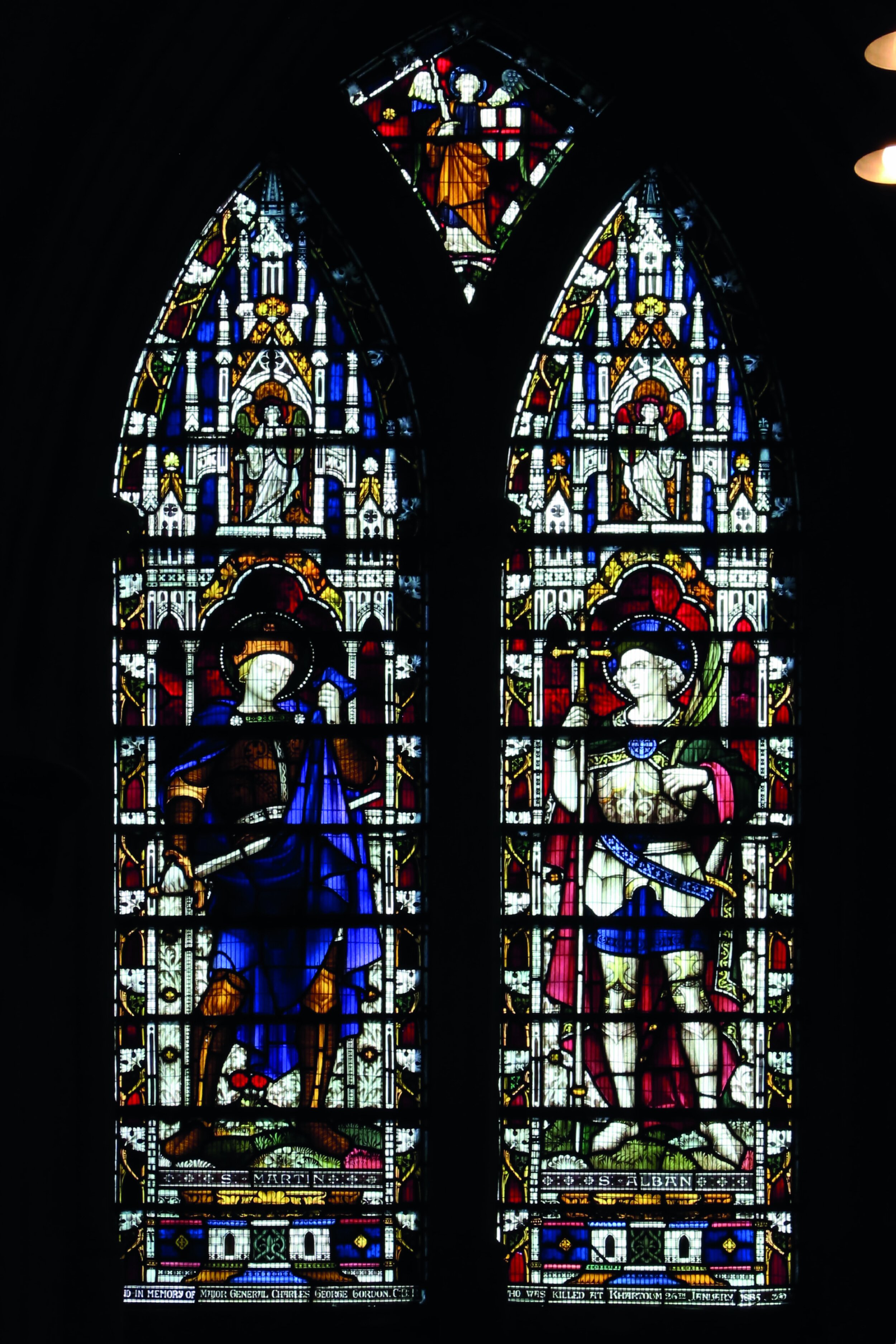
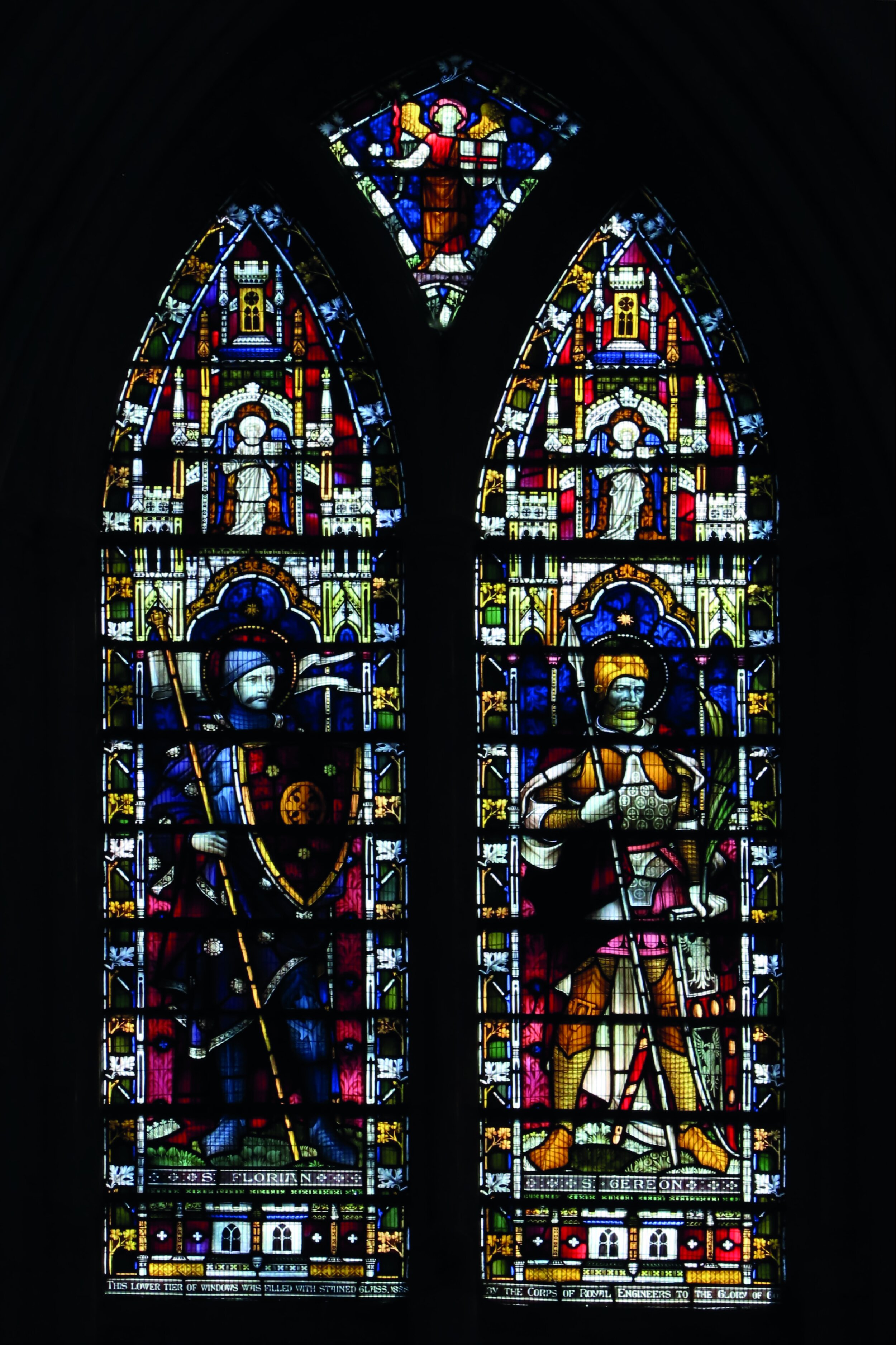
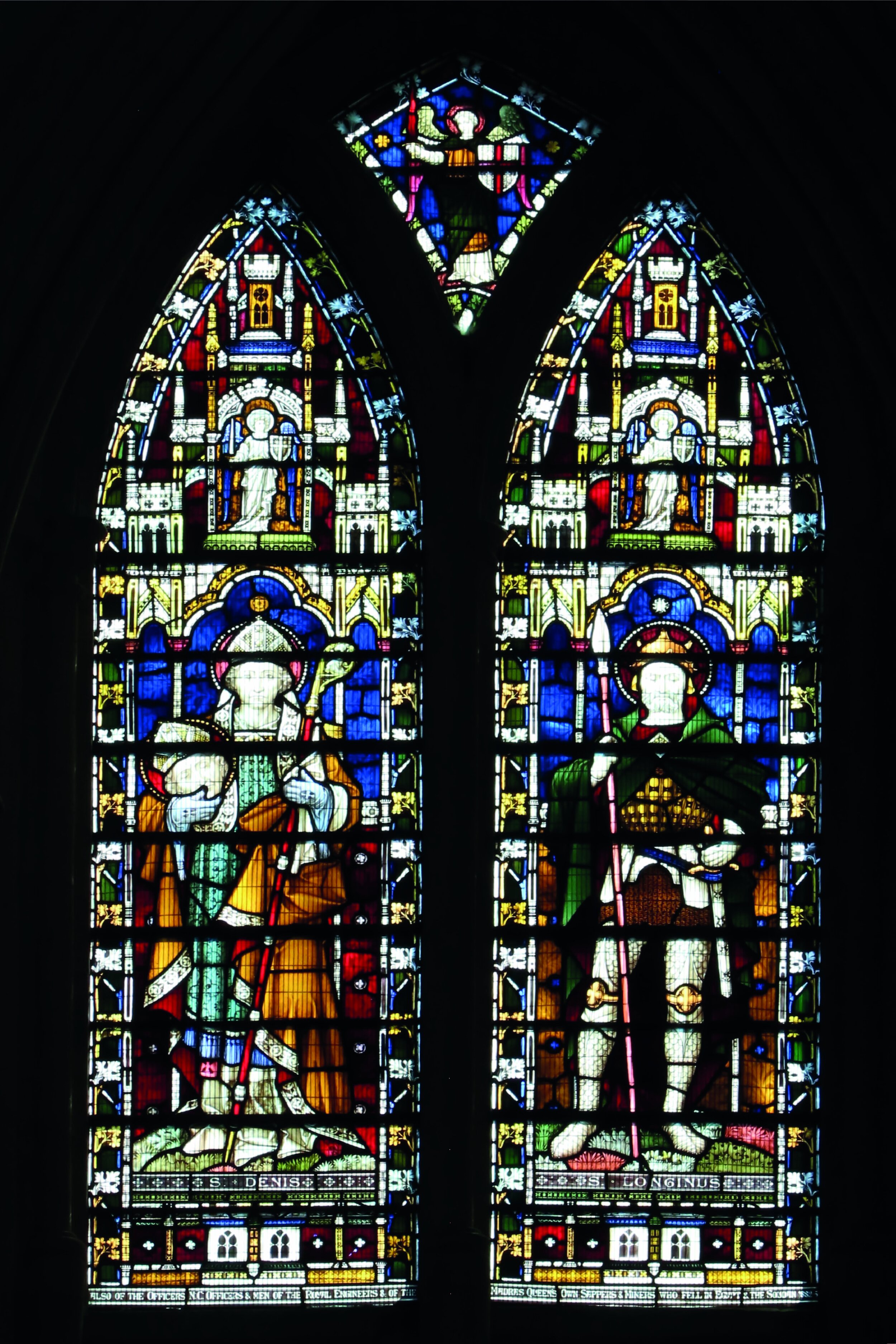
St Florian, St Gereon, St Martin, St Alban, St Denis, and St Longinus, south nave transept lower tier
Clayton & Bell, 1888. Marble plaque underneath - inscription 'This lower tier of windows was filled with stained glass by the Corps of Royal Engineers to the Glory of God/and in memory of General Charles George Gordon CB who was killed at Khartoum, 26th January 1885. Also of the Officers, NC Officers and Men of the Royal Engineers and the Madras Queen's Own Sappers & Miners who fell in Egypt and the Sudan 1882-5'. Each figure beneath an architectural canopy in the centre of which stands an angel with a shield and drawn sword. Headlight - an angel with a shield and drawn sword. Headlight - an angel with shield and drawn sword.
Bishop Ernulf, south quire aisle south wall (1 of 3)
Powell of Whitefriars, after 1917. Inscription 'These two windows have been placed/here to the glory of God and in memory/of Thomas Hellyar Foord of Acorn House Rochester and the Grange, Botley, Southampton, who died on the 12th March 1917'. (Physick No.69). Inscription on a scroll held by two angels, 'Bishop Ernulf'. Above, figure of Ernulf in bishop's vestments, holding a crozier and a scroll with a plan of the Cathedral. Scene beneath of two monks, one sitting at a writing desk talking to another who holds a rolled scroll.
David playing his harp, south quire aisle south wall (2 of 3)
Burlison & Grylls, after 1918. Mural marble tablet records 'D.O.M./In loving memory of/Cecil Fearnley/15th London Regiment/Civil Service Rifles/killed in action at/Festubert 12th May 1915/Dulce et decorum est/pro patria mori'. Inscription 'David took an harp and played with his hand'. Above, an angel holding a scroll with music (the opening bars of Handel's Largo). Below, the badge of the 15th Battalion London Regiment Civil Service Rifles.
Bishop Hamo de Hythe, south quire aisle south wall (3 of 3)
Powell of Whitefriars, after 1917. In memory of Thomas Hellyar Foord. Inscription 'Bp Hamo de Hythe'. Above, the bishop stands, in vestments and mitre, holding a model of Rochester Cathedral in both hands.
Miracle of the healing of the nobleman's son, north quire transept north wall (1 of 3)
Clayton & Bell; 1883. Brass mural plate below 'In grateful recognition of the/recovery of Thomas Clifford Aveling/a scholar of the Cathedral School 1883'. Small window in lowest tier, western recess. Illustrates the miracle of the healing of the nobleman's son. Scene of Christ, speaking to the nobleman beneath a tree. Scroll above the figure of Christ with the words 'Go thy way, thy son liveth'. Inscription below 'At that hour the fever left him'.
Christ, Mary and Child, St William of Perth, John the Baptist, north quire transept north wall behind Bishop Walter de Merton’s tomb
Comper, 1911. Window divided into two parts, each of two lights. Western pair. West, Christ holding the souls of the departed in human form in a napkin. East, figure of Mary crowned, holding Infant Jesus. A scroll curves above the figure with the inscription 'Sancta Maria Virgo'. Above, a quatrefoil containing the arms of Merton. Eastern pair. West, figure of St William of Perth in pilgrim dress with hat, staff and bag. Inscription above in a curving scroll 'S Guilielmus de Perth'. East, inscription 'Sanctus Johannes Baptista'. Above, figure of the saint dressed in an animal skin, holding a reed cross and a roundel of the Lamb of God. Above, a quatrefoil containing the arms of Merton impaled with the See of Rochester. Inscription below all four lights 'Domini est Assumpcio nostra qui timet dominum faciet bona MCMXI'.
St Gregory, north quire transept north wall upper tier
Clayton & Bell, after 1887. Mural brass plate below 'To the Glory of God and in ever loving memory of Capt. Wm. Walton Robinson Royal Engineers. Son of the late Colonel W. Robinson RE who died at Aden 7th June, 1887 aged thirty seven years. The upper centre window has been placed by his widow'. (Physick No.36). Inscription 'Sanctus Gregorius'. Above, figure of the saint in papal vestments with tiara and pontifical crozier, his right hand held up in blessing and a dove on his right shoulder, boys and inscription 'Non Angli sed Angeli'.
Bishop Gundulf, north quire transept north wall lower tier (1 of 3)
Clayton & Bell, after 1885. Given in memory of Canon S. Dewe who died in 1885. Inscription 'S. Gundulph', above, figure of Gundulf in bishop's robes with mitre and crozier, holding Rochester Castle in his arm, beneath an architectural canopy. Scene below, Gundulf holding the plan of his Cathedral, with a workman laying a stone using a mallet and a workman holding a set square. To the left of Gundulf stand two acolytes holding candles.
Gilbert de Glanville, Laurentius de S. Martin, John de Bradfield, Thomas de Inglethorpe, Haymo de Hethe, John de Sheppey, John Lowe, John Warner, St. Paulinus, King Edwin of Northumbria with Paulinus, north quire transept north wall lower tier (2 of 3)
Clayton & Bell, after 1860. Inscription 'To the Glory of God and in loving memory of George Murray, Consecrated Bishop of Sodor and Man 1812. Translated to the See of Rochester 1827. Departed February 16th 1860, aged 76 years. His children have erected this window representing St Paulinus, the third Bishop of Rochester'. Inscription 'Sanctus Paulinus'. Above, figure of Paulinus in bishop's robes, holding a book with his right hand held in benediction. On either side of the figure is a vertical row of four bishops of Rochester, labeled from the west, from the top Gilbert de Glanville, Laurentius de S. Martin, Ioannes de Bradfield, Thomas de Inglethorpe, and on the east Haymo de Hethe, Ioannes de Sheppey, Ioannes Lowe, Ioannes Warner, the whole beneath an architectural canopy. Below, scene of King Edwin of Northumbria seated, with Paulinus standing and laying his hand on Edwin's head, accompanied by an acolyte who carries a candle.
Christ the Shepherd
Clayton & Bell, after 1879. In memory of Canon Griffith who died in 1879. One of a series of four windows with allusions to Christ as the Good Shepherd. Three lights with inscription below. 'He shall separate them as a shepherd divideth (gap-damaged glass) the goats'. In the centre light Christ crowned and seated on a throne, beneath an architectural canopy with an angel above. Below, scene of Christ the shepherd dividing the sheep and the goats. The sheep go off to his right with an angel with a crook, the goats to the left with an angel with a sword. In the small cusped head lights a sunburst with putti.
Christ Crucified, north quire transept north wall lower tier (2 of 3)
Clayton & Bell, 1869. Inscription 'In memory of Joseph Oates Travers CB Major Inspector General Marines. Died March 23 1869. Aged 54 Yr'. The Crucifixion. One of a series of four on the theme of Christ the Good Shepherd (See also Nos 000119/000120/000149). Three lights. Centre light, Christ crucified, with Mary and John at the foot of the cross. Inscription, 'God is love'. West light, Mary Magdalene and the third Mary(?) and a mounted Roman knight, wearing medieval armour. East light, soldiers wearing helmets and chain mail, one with a lance, and a figure kneeling, holding a flowering rod (?) St Joseph (?) All three sets beneath architectural canopies. Below, scene across three lights. West - the three Marys visit the sepulchre. Centre - an angel sits in the centre of the broken tomb. East - two male figures, St Peter (with keys) and St John (?) Three head lights with angels, one holding a helmet, another a breastplate (topmost light damaged). Originally in the Great East Window. Moved in 1872.
St Matthew, St Thomas, St Mark, north quire transept north wall lower tier (1 of 3)
The Ascension, north quire transept east wall (2 of 2)
Clayton & Bell, after 1875. Inscription 'In memoriam F.N. Hassard RE obit 7 May 1875 Aetat 27'. Mural brass plate records 'This window is in memory of Lieutenant/Fairfax Norman Hassard RE eldest son of/Colonel Fairfax Charles Hassard CB RE who/died at Mhow, India on the/Indore State Railway'. (Physick No.42). The Ascension with inscription 'Ascendo ad patrem meum et patrem vestrum'. The eleven Apostles, kneeling, watch as Christ ascends, with an angel on either side holding a banner inscribed. 'Viri Galilaei quid statis aspicientes in caelum'. The figure of Christ is framed in a mandorla.

